Sierra Wireless Q2687 Wireless CPU (850/900/1800/1900 MHz) User Manual Q2687 PTS rev002
Sierra Wireless, Inc. Wireless CPU (850/900/1800/1900 MHz) Q2687 PTS rev002
Contents
- 1. User Manual
- 2. Users Manual
User Manual

Wireless CPU Quik Q2687
Product Technical Specification
Reference: WA_ENG_Q2687_PTS_001
Revision: 002
Date: September 11, 2006
Powered by the Wavecom Operating System and Open AT®

Wireless CPU Quik Q2687
©Confidential Page: 2 / 92
This document is the sole and exclusive property of Wavecom. Not to be distributed or divulged without
prior written agreement.
WA_ENG_Q2687_PTS_001-002 September 11, 2006
Cautions
This platform contains a modular transmitter. This device is used for wireless
applications. Note that all electronics parts and elements are ESD sensitive.
Information provided herein by WAVECOM is accurate and reliable. However, no
responsibility is assumed for its use and any of such WAVECOM information is herein
provided "as is" without any warranty of any kind, whether express or implied.
General information about WAVECOM and its range of products is available at the
following internet address: http://www.wavecom.com
Trademarks
®, WAVECOM®, WISMO®, Open AT® and certain other trademarks and logos
appearing on this document, are filed or registered trademarks of Wavecom S.A. in
France or in other countries. All other company and/or product names mentioned may
be filed or registered trademarks of their respective owners.
Copyright
This manual is copyrighted by WAVECOM with all rights reserved. No part of this
manual may be reproduced in any form without the prior written permission of
WAVECOM. No patent liability is assumed with respect to the use of their respective
owners.

Wireless CPU Quik Q2687
©Confidential Page: 3 / 92
This document is the sole and exclusive property of Wavecom. Not to be distributed or divulged without
prior written agreement.
WA_ENG_Q2687_PTS_001-002 September 11, 2006
Overview
This document defines and specifies the Wireless CPU Quik Q2687, available under
this version:
• Q2687: EGSM/GPRS/EDGE 900/1800/850/1900 MHz version with 32 Mb of
Burst Flash memory and 8 Mb of SRAM (32/8)

Wireless CPU Quik Q2687
©Confidential Page: 4 / 92
This document is the sole and exclusive property of Wavecom. Not to be distributed or divulged without
prior written agreement.
WA_ENG_Q2687_PTS_001-002 September 11, 2006
Document History
Level Date List of revisions
001 07/12/2005 Creation (Preliminary version)
002 03/01/2006 Reference number changed to
WA_ENG_Q2687_PTS_001.
Overview - Memory changed to SRAM
"Parallel" word is added on the second line of the first
paragraph.(Chapter 2.1)
Input Supply voltage added, Vmin = 3.2V and Vmax =
4.5V (Chapter 2.2.1
Power Consumption table for EDGE is added (Chapter
2.2.2)
Parallel Interface table, pins 51 and 53 are labeled as
GPIO1 and GPIO2 (Chapter 2.5)
Auxiliary Microphone (MIC1) external bias is added and
typical application circuit Chapter 2.12.1.3)
Electrical Characteristics Table, maximum CHG_IN
Voltage is changed to 6.0V (Chapter 2.13)
Notes on Caution, Trademark and Copyright is updated
General Description has been modified (Chapter 1)
Functional architecture is modified (Chapter 1.2)
Dimensions typo error is corrected (Chapter 1.1.1)
"Soldered connection" and "UFL Connector" are added for
RF connection (Chapter 1.1.6)
003 28/07/2006 "Overview" updated
"Table of Figures" added
"Caution" updated
0: "References" added
2: "General Description" updated
2.1.4 : "Interfaces" updated
2.1.6 : "Connection interfaces" updated
1.1 : "Functional description" updated
3.1: "General Purpose Connector (GPC)" updated
3.2: "Power supply description" updated
3.2.1 : "Power Consumption" updated
3.3: " Electrical information for digital I/O" updated
3.4: "Serial interface" updated
3.5: "Parallel interface" updated
3.7: "Main Serial link (UART1)" updated
3.8: "Auxiliary serial link (UART2)" updated

Wireless CPU Quik Q2687
©Confidential Page: 5 / 92
This document is the sole and exclusive property of Wavecom. Not to be distributed or divulged without
prior written agreement.
WA_ENG_Q2687_PTS_001-002 September 11, 2006
Level Date List of revisions
1.1: "General Purpose Input/output" updated
3.11: "Analog to Digital Converter" updated
3.12: "Digital to Analog Converter" added
3.13: "Temperature Sensor Interface" added
1.1: "Analog audio interface" updated
3.15: "Buzzer output" updated
3.16: "Battery charging interface" updated
3.17: "ON/~OFF signal" updated
3.18: "BOOT signal" updated
3.19: "Reset signal (~RESET)" updated
3.20: "External interrupt" updated
3.21: "VCC_2V8 and VCC_1V8 output" updated
3.22 "BAT-RTC (Backup Battery)" updated
3.23: "FLASH-LED signal" updated
3.24: "Digital audio interface (PCM)" updated
3.25: "USB 2.0 interface" added
3.26.1: "RF connections" updated
0: "Caution: " updated
4: "Technical specification" updated
4.2: "Environmental Specification" updated
5: " Connector and peripheral device references" updated

Wireless CPU Quik Q2687
©Confidential Page: 6 / 92
This document is the sole and exclusive property of Wavecom. Not to be distributed or divulged without
prior written agreement.
WA_ENG_Q2687_PTS_001-002 September 11, 2006
Contents
1 References ................................................................................11
1.1 Reference Documents.......................................................................... 11
1.1.1 Wavecom Reference Documents .................................................. 11
1.1.2 General Reference Document ....................................................... 11
1.2 List of abbreviations ............................................................................ 11
2 General Description...................................................................15
2.1 General Information ............................................................................. 15
2.1.1 Overall Dimensions ...................................................................... 15
2.1.2 Environment and Mechanics........................................................ 15
2.1.3 GSM/GPRS/EGPRS Features......................................................... 15
2.1.4 Interfaces..................................................................................... 15
2.1.5 Operating System ........................................................................ 16
2.1.6 Connection Unterfaces ................................................................. 16
2.2 Functional Architecture........................................................................ 17
2.2.1 RF Functionalities ........................................................................ 18
2.2.2 Baseband Functionalities ............................................................. 18
2.3 Operating System................................................................................ 18
3 Interfaces ..................................................................................19
3.1 General Purpose Connector (GPC)........................................................ 19
3.2 Power Supply...................................................................................... 19
3.2.1 Power Consumption .................................................................... 21
3.2.1.1 Power Consumption without Open AT® Processing ................ 21
3.2.1.2 Power Consumption with Open AT® Software ........................ 23
3.2.1.3 Consumption Waveform Samples .......................................... 25
3.2.1.4 Power Supply Pin-out ............................................................ 27
3.3 Electrical Information for Digital I/O...................................................... 28
3.4 Serial Interface .................................................................................... 30
3.4.1 SPI Bus........................................................................................ 30
3.4.1.1 SPI Waveforms ...................................................................... 30
3.4.1.2 SPI Configuration ................................................................... 31
3.4.1.3 SPI1 Bus................................................................................ 31
3.4.1.4 SPI2 Bus................................................................................ 32
3.4.2 I²C bus ........................................................................................ 32
3.4.2.1 I²C Waveforms ....................................................................... 33
3.4.2.2 I²C Bus pin-out ...................................................................... 33
3.5 Parallel Interface .................................................................................. 34
3.6 Keyboard Interface............................................................................... 35

Wireless CPU Quik Q2687
©Confidential Page: 7 / 92
This document is the sole and exclusive property of Wavecom. Not to be distributed or divulged without
prior written agreement.
WA_ENG_Q2687_PTS_001-002 September 11, 2006
3.7 Main Serial Link (UART1)..................................................................... 36
3.8 Auxiliary Serial Link (UART2) ............................................................... 38
3.9 SIM Interface....................................................................................... 38
3.9.1 General Description...................................................................... 38
3.10 General Purpose Input/Output ............................................................. 41
3.11 Analog to Digital Converter.................................................................. 43
3.12 Digital to Analog Converter.................................................................. 44
3.13 Temperature Sensor Interface .............................................................. 45
3.14 Analog Audio Onterface....................................................................... 46
3.14.1 Microphone Inputs....................................................................... 47
3.14.1.1 Common microphone input characteristics............................. 47
3.14.1.2 Main Microphone Inputs (MIC2)............................................. 47
3.14.1.3 Auxiliary Microphone Inputs (MIC1) ....................................... 47
3.14.1.4 Microphone Electrical Characteristics ..................................... 48
3.14.2 Common Speaker Output Characteristics ..................................... 49
3.14.2.1 Differential Connection ........................................................... 49
3.14.2.2 Single-ended Connection ....................................................... 49
3.14.3 Speaker Outputs .......................................................................... 49
3.14.3.1 Speaker 2 Outputs ................................................................. 49
3.14.3.2 Speaker 1 Outputs ................................................................. 50
3.14.3.3 Speaker Output Power ........................................................... 50
3.15 Buzzer Output ..................................................................................... 51
3.16 Battery Charging Interface ................................................................... 52
3.16.1 Ni-Cd / Ni-Mh Charging Algorithm ............................................... 52
3.16.2 Li-Ion Charging Algorithm ............................................................ 53
3.16.3 Controlled Pre-charging Hardware ............................................... 54
3.16.4 Temperature Monitoring .............................................................. 54
3.17 ON / ~OFF Signal................................................................................. 55
3.17.1 Operating Sequences................................................................... 55
3.17.1.1 Power ON .............................................................................. 55
3.17.1.2 Power OFF............................................................................. 56
3.18 BOOT Signal ....................................................................................... 57
3.19 Reset Signal (~RESET)......................................................................... 58
3.20 External Interrupt ................................................................................ 59
3.21 VCC_2V8 and VCC_1V8 Output ............................................................ 60
3.22 BAT-RTC (Back-up Battery) ................................................................. 61
3.22.1 Interface Description .................................................................... 61
3.23 FLASH-LED Signal ............................................................................... 62
3.24 Digital Audio Interface (PCM)............................................................... 64
3.24.1 Description .................................................................................. 64
3.25 USB 2.0 Interface ................................................................................ 67

Wireless CPU Quik Q2687
©Confidential Page: 8 / 92
This document is the sole and exclusive property of Wavecom. Not to be distributed or divulged without
prior written agreement.
WA_ENG_Q2687_PTS_001-002 September 11, 2006
3.26 RF Interface ......................................................................................... 68
3.26.1 RF Connections............................................................................ 68
3.26.2 RF Performance ........................................................................... 68
3.26.3 Antenna Specifications ................................................................ 69
4 Technical Specifications ...........................................................71
4.1 General Purpose Connector Pin-out Description ................................... 71
4.2 Environmental Specifications ............................................................... 75
4.3 Mechanical specifications.................................................................... 77
4.3.1 Physical Characteristics ............................................................... 77
4.3.2 Mechanical Drawings .................................................................. 77
5 Connector and Peripheral Device References ............................79
5.1 General Purpose Connector ................................................................. 79
5.2 SIM Card Reader ................................................................................. 79
5.3 Microphone......................................................................................... 79
5.4 Speaker ............................................................................................... 80
5.5 Antenna Cable..................................................................................... 80
5.6 RF board-to-board Connector .............................................................. 80
5.7 GSM Antenna ..................................................................................... 80
6 Design Guidelines ...................................................................... 81
6.1 Hardware and RF ................................................................................ 81
6.1.1 EMC Recommendations............................................................... 81
6.1.2 Power Supply .............................................................................. 81
6.1.3 Layout Requirement..................................................................... 83
6.1.4 Antenna....................................................................................... 84
6.2 Mechanical Integration ........................................................................ 84
6.3 Operating System Upgrade.................................................................. 84
7 Appendix ...................................................................................85
7.1 Standards and Recommendations ....................................................... 85
7.2 Safety Recommendations (for Information only) ................................... 89
7.2.1 RF Safety ..................................................................................... 89
7.2.1.1 General .................................................................................. 89
7.2.1.2 Exposure to RF energy ........................................................... 89
7.2.1.3 Efficient Terminal Operation ................................................... 90
7.2.1.4 Antenna Care and Replacement ............................................. 90
7.2.2 General Safety ............................................................................. 90
7.2.2.1 Driving................................................................................... 90

Wireless CPU Quik Q2687
©Confidential Page: 9 / 92
This document is the sole and exclusive property of Wavecom. Not to be distributed or divulged without
prior written agreement.
WA_ENG_Q2687_PTS_001-002 September 11, 2006
7.2.2.2 Electronic Devices .................................................................. 90
7.2.2.3 Vehicle Electronic Equipment ................................................. 91
7.2.2.4 Medical Electronic Equipment ................................................ 91
7.2.2.5 Aircraft .................................................................................. 91
7.2.2.6 Children ................................................................................. 91
7.2.2.7 Blasting Areas........................................................................ 91
7.2.2.8 Potentially Explosive Atmospheres ......................................... 91

Wireless CPU Quik Q2687
©Confidential Page: 10 / 92
This document is the sole and exclusive property of Wavecom. Not to be distributed or divulged without
prior written agreement.
WA_ENG_Q2687_PTS_001-002 September 11, 2006
Table of Figures
Figure 1: Functional architecture .............................................................................17
Figure 2: Power supply during burst emission .........................................................20
Figure 3: SPI Timing diagrams, Mode 0, Master, and 4-wire....................................31
Figure 4: I²C Timing diagrams, Master ....................................................................33
Figure 5: Characteristics of the Temperature Sensor ................................................45
Figure 6 : Ni-Cd / Ni-Mh charging waveform............................................................52
Figure 7: Li-Ion full-charging waveform ...................................................................53
Figure 8 : Power-ON sequence (no PIN code activated)............................................56
Figure 9 : Power-OFF sequence...............................................................................56
Figure 10: Reset sequence waveform ......................................................................58
Figure 11: Real Time Clock power supply ................................................................61
Figure 12: FLASH-LED state during RESET and Initialization time ............................63
Figure 13: PCM frame waveform .............................................................................65
Figure 14: PCM sampling waveform........................................................................66
Figure 17: Environmental classes ............................................................................76
Figure 18: Layout requirement.................................................................................83

Wireless CPU Quik Q2687
References
©Confidential Page: 11 / 92
This document is the sole and exclusive property of Wavecom. Not to be distributed or divulged without
prior written agreement.
WA_ENG_Q2687_PTS_001-002 September 11, 2006
1 References
1.1 Reference Documents
For more details, several reference documents may be consulted. The Wavecom
reference documents are provided in the Wavecom documents package, contrary to
the general reference documents which are not authored by Wavecom.
1.1.1 Wavecom Reference Documents
[1] Automotive Environmental Control Plan for Q2687 Wireless CPU
WM_QUA_Q2687_DCP_001
[2] Q2687 Wireless CPU Customer Design Guidelines
WM_DEV_Q2687_PTS_007
[3] Q2687 Wireless CPU Process Customer Guidelines
WM_PRJ_Q2686_PTS_004
[4] AT Commands Interface Guide for OS 6.61
WM_DEV_OAT_UGD_014
1.1.2 General Reference Document
[5] "I²C Bus Specification", Version 2.0, Philips Semiconductor 1998
[6] ISO 7816-3 Standard
1.2 List of abbreviations
Abbreviations Definition
AC Alternating Current
ADC Analog to Digital Converter
A/D Analog to Digital conversion
AF Audio-Frequency
AT ATtention (prefix for modem commands)
AUX AUXiliary
CAN Controller Area Network
CB Cell Broadcast

Wireless CPU Quik Q2687
References
©Confidential Page: 12 / 92
This document is the sole and exclusive property of Wavecom. Not to be distributed or divulged without
prior written agreement.
WA_ENG_Q2687_PTS_001-002 September 11, 2006
Abbreviations Definition
CEP Circular Error Probable
CLK CLocK
CMOS Complementary Metal Oxide Semiconductor
CS Coding Scheme
CTS Clear To Send
DAC Digital to Analog Converter
dB Decibel
DC Direct Current
DCD Data Carrier Detect
DCE Data Communication Equipment
DCS Digital Cellular System
DR Dynamic Range
DSR Data Set Ready
DTE Data Terminal Equipment
DTR Data Terminal Ready
EDGE Enhance Data rates for GSM Evolution
EFR Enhanced Full Rate
E-GSM Extended GSM
EGPRS Enhance GPRS
EMC ElectroMagnetic Compatibility
EMI ElectroMagnetic Interference
EMS Enhanced Message Service
EN ENable
ESD ElectroStatic Discharges
FIFO First In First Out
FR Full Rate
FTA Full Type Approval
GND GrouND
GPI General Purpose Input
GPC General Purpose Connector
GPIO General Purpose Input Output
GPO General Purpose Output

Wireless CPU Quik Q2687
References
©Confidential Page: 13 / 92
This document is the sole and exclusive property of Wavecom. Not to be distributed or divulged without
prior written agreement.
WA_ENG_Q2687_PTS_001-002 September 11, 2006
Abbreviations Definition
GPRS General Packet Radio Service
GPS Global Positioning System
GSM Global System for Mobile communications
HR Half Rate
I/O Input / Output
LED Light Emitting Diode
LNA Low Noise Amplifier
MAX MAXimum
MIC MICrophone
MIN MINimum
MMS Multimedia Message Service
MO Mobile Originated
MT Mobile Terminated
na Not Applicable
NF Noise Factor
NMEA National Marine Electronics Association
NOM NOMinal
NTC Negative Temperature Coefficient
PA Power Amplifier
Pa Pascal (for speaker sound pressure measurements)
PBCCH Packet Broadcast Control CHannel
PC Personal Computer
PCB Printed Circuit Board
PDA Personal Digital Assistant
PFM Power Frequency Modulation
PSM Phase Shift Modulation
PWM Pulse Width Modulation
RAM Random Access Memory
RF Radio Frequency
RFI Radio Frequency Interference
RHCP Right Hand Circular Polarization
RI Ring Indicator

Wireless CPU Quik Q2687
References
©Confidential Page: 14 / 92
This document is the sole and exclusive property of Wavecom. Not to be distributed or divulged without
prior written agreement.
WA_ENG_Q2687_PTS_001-002 September 11, 2006
Abbreviations Definition
RST ReSeT
RTC Real Time Clock
RTCM Radio Technical Commission for Maritime services
RTS Request To Send
RX Receive
SCL Serial CLock
SDA Serial DAta
SIM Subscriber Identification Wireless CPU
SMS Short Message Service
SPI Serial Peripheral Interface
SPL Sound Pressure Level
SPK SPeaKer
SRAM Static RAM
TBC To Be Confirmed
TDMA Time Division Multiple Access
TP Test Point
TVS Transient Voltage Suppressor
TX Transmit
TYP TYPical
UART Universal Asynchronous Receiver-Transmitter
USB Universal Serial Bus
USSD Unstructured Supplementary Services Data
VSWR Voltage Standing Wave Ratio

Wireless CPU Quik Q2687
General Description
©Confidential Page: 15 / 92
This document is the sole and exclusive property of Wavecom. Not to be distributed or divulged without
prior written agreement.
WA_ENG_Q2687_PTS_001-002 September 11, 2006
2 General Description
2.1 General Information
Wireless CPU Quik Q2687 is a self-contained E-GSM/GPRS/EDGE 900/1800 and
850/1900 quad-band Wireless CPU with the following features:
2.1.1 Overall Dimensions
• Length: 40 mm
• Width: 32.2 mm
• Thickness: 4 mm
2.1.2 Environment and Mechanics
• Green policy: RoHS compliant
• Complete shielding
The Q2687 Wireless CPU is compliant with RoHS (Restriction of Hazardous
Substances in Electrical and Electronic Equipment) Directive 2002/95/EC which
sets limits for the use of certain restricted hazardous substances. This directive
states that "from 1st July 2006, new electrical and electronic equipment put on
the market does not contain lead, mercury, cadmium, hexavalent chromium,
polybrominated biphenyls (PBB), and polybrominated diphenyl ethers (PBDE)".
Wireless CPUs which are compliant with this directive
are identified by the RoHs logo on their label.
2.1.3 GSM/GPRS/EGPRS Features
• 2-Watt EGSM – GPRS 900/850 radio section running under 3.6 Volts
• 1-Watt GSM-GPRS1800/1900 radio section running under 3.6 Volts
• 0.5-Watt EGPRS 900/850 radio section running under 3.6 Volts
• 0.4-Watt EGPRS 1800/1900 radio section running under 3.6 Volts
• Hardware GSM/GPRS class 10 and EGPRS class 10 capable
2.1.4 Interfaces
• Digital section running under 2.8V and 1.8V.
• 3V/1V8 SIM interface
• Complete interfacing:
o Power supply

Wireless CPU Quik Q2687
General Description
©Confidential Page: 16 / 92
This document is the sole and exclusive property of Wavecom. Not to be distributed or divulged without
prior written agreement.
WA_ENG_Q2687_PTS_001-002 September 11, 2006
o Serial link
o Analog audio
o PCM digital audio
o SIM card
o Keyboard
o USB 2.0 slave
o Serial LCD (not available with AT commands)
o Parallel port for specific applications (under Open AT® control only) TBD
2.1.5 Operating System
• Real Time Clock (RTC) with calendar
• Battery charger
• Echo Cancellation + noise reduction (quadri codec)
• Full GSM or GSM/GPRS Operating System stack
2.1.6 Connection Unterfaces
Wireless CPU Quik Q2687 has four external connections:
• Three for RF circuit:
o UFL connector
o Soldered connection
o IMP connection
• One for baseband signals:
o 100-pin I/O connector (compatible with Wireless CPU Quik Q2686)
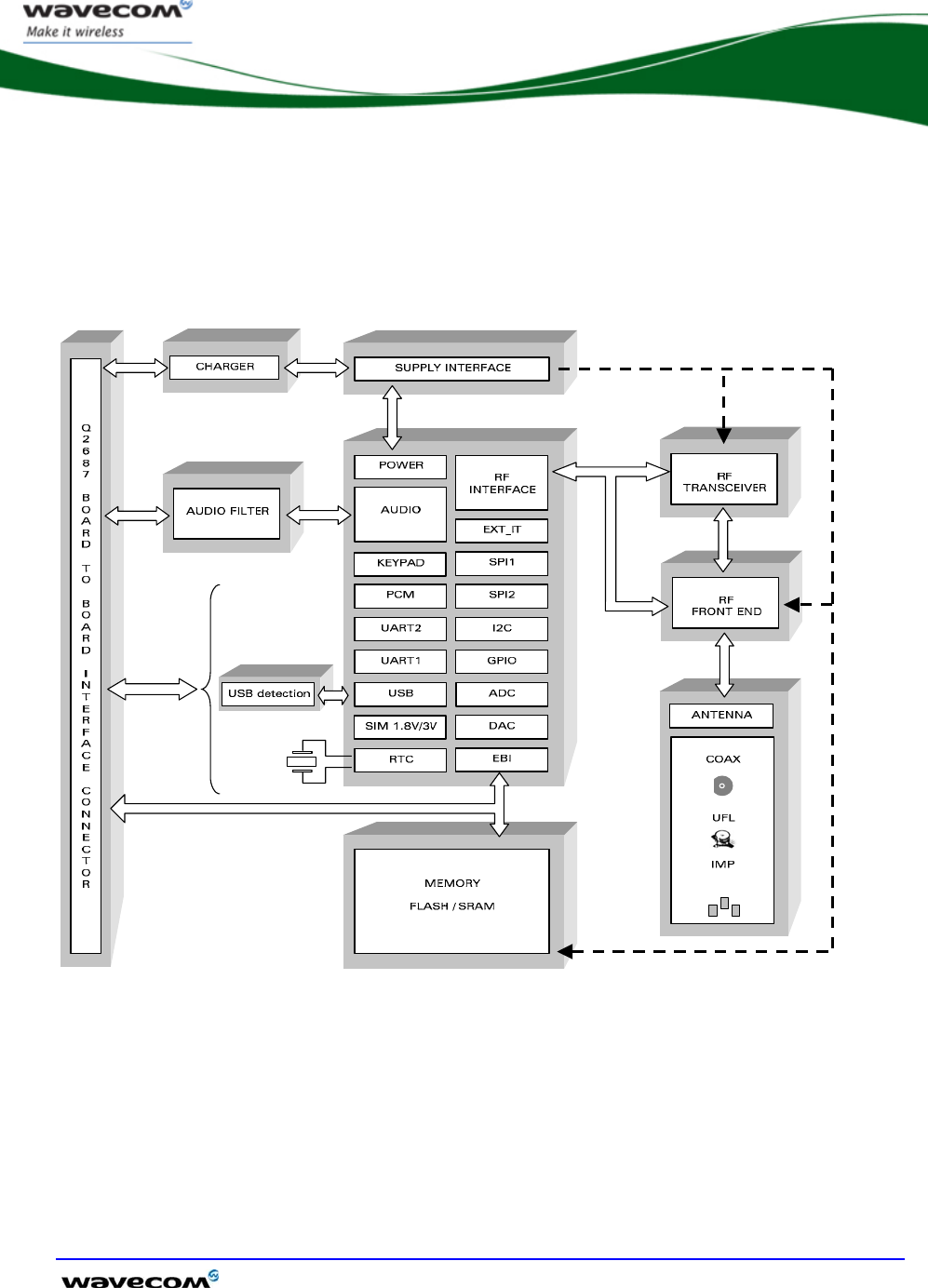
Wireless CPU Quik Q2687
General Description
©Confidential Page: 17 / 92
This document is the sole and exclusive property of Wavecom. Not to be distributed or divulged without
prior written agreement.
WA_ENG_Q2687_PTS_001-002 September 11, 2006
2.2 Functional Architecture
The global architecture of the Wireless CPU Quik Q2687 is described below:
Figure 1: Functional architecture

Wireless CPU Quik Q2687
General Description
©Confidential Page: 18 / 92
This document is the sole and exclusive property of Wavecom. Not to be distributed or divulged without
prior written agreement.
WA_ENG_Q2687_PTS_001-002 September 11, 2006
2.2.1 RF Functionalities
The Radio Frequency (RF) functionalities complies with the Phase II EGSM 900/DCS
1800 and GSM 850/PCS 1900 recommendation. The frequencies are:
Transmit band (Tx) Receive band (Rx)
GSM 850 824 to 849 MHz 869 to 894 MHz
E-GSM 900 880 to 915 MHz 925 to 960 MHz
DCS 1800 1710 to 1785 MHz 1805 to 1880 MHz
PCS 1900 1850 to 1910 MHz 1930 to 1990 MHz
The Radio Frequency (RF) part is based on a specific quad-band chip with a:
• Quad-band LNAs (Low Noise Amplifier)
• Direct Conversion Receiver
• Offset PLL/PL (Phase Locked Loop and Polar Loop) transmitter
• Frequency synthesizer
• Digitally controlled crystal oscillator (DCXO)
• Tx/Rx FEM (Front-End module) for quad-band GSM/GPRS
2.2.2 Baseband Functionalities
The digital part of the Wireless CPU Quik Q2687 is composed of a PCF5213 PHILIPS
chip. This chipset uses a 0,18 µm mixed technology CMOS, which allows massive
integration as well as low current consumption.
2.3 Operating System
Wireless CPU Quik Q2687 is designed to integrate various types of specific process
applications such as vertical applications (telemetry, multimedia, automotive).
The Operating System offers a set of AT commands to control the Wireless CPU. With
this standard Operating System, some interfaces of the Wireless CPU are not
available, since they are dependent on the peripheral devices connected to the
Wireless CPU.
The Operating System is Open AT® compliant.

Wireless CPU Quik Q2687
Interfaces
©Confidential Page: 19 / 92
This document is the sole and exclusive property of Wavecom. Not to be distributed or divulged without
prior written agreement.
WA_ENG_Q2687_PTS_001-002 September 11, 2006
3 Interfaces
3.1 General Purpose Connector (GPC)
A 100-pin connector is provided to interface the Wireless CPU Quik Q2687 with a
board containing a serial or parallel LCD module, a keyboard, a SIM connector, and a
battery connection.
The interfaces available on the GPC are described below.
chapter Name Driven by
AT commands
Driven by
Open AT®
3.4 Sérial Interface X
3.5 Parallel Interface X
3.6 Keyboard Interface X X
3.7 Main Sérial Link X X
3.8 Auxiliary Sérial Link X X
3.9 SIM Interface X X
3.10 Général Purpose IO X X
3.11 Analog to Digital Converter X X
3.12 Analog audio Interface X X
3.13 PWM / Buzzer Output X X
3.14 Battery Charging Interface X X
3.18 External Interruption X X
3.20 BAT-RTC (Backup Battery) X X
3.21 FLASH-LED signal X X
3.22 Digital Audio Interface (PCM) X X
3.23 USB 2.0 Interface X X
3.2 Power Supply
The power supply is one of the key issues in the design of a GSM terminal.
Due to the burst emission mode used in GSM / GPRS, the power supply must be able
to deliver high current peaks in a short time. During the peaks, the ripple (Uripp) on
the supply voltage must not exceed a certain limit (see Table 1 Power supply
voltage).
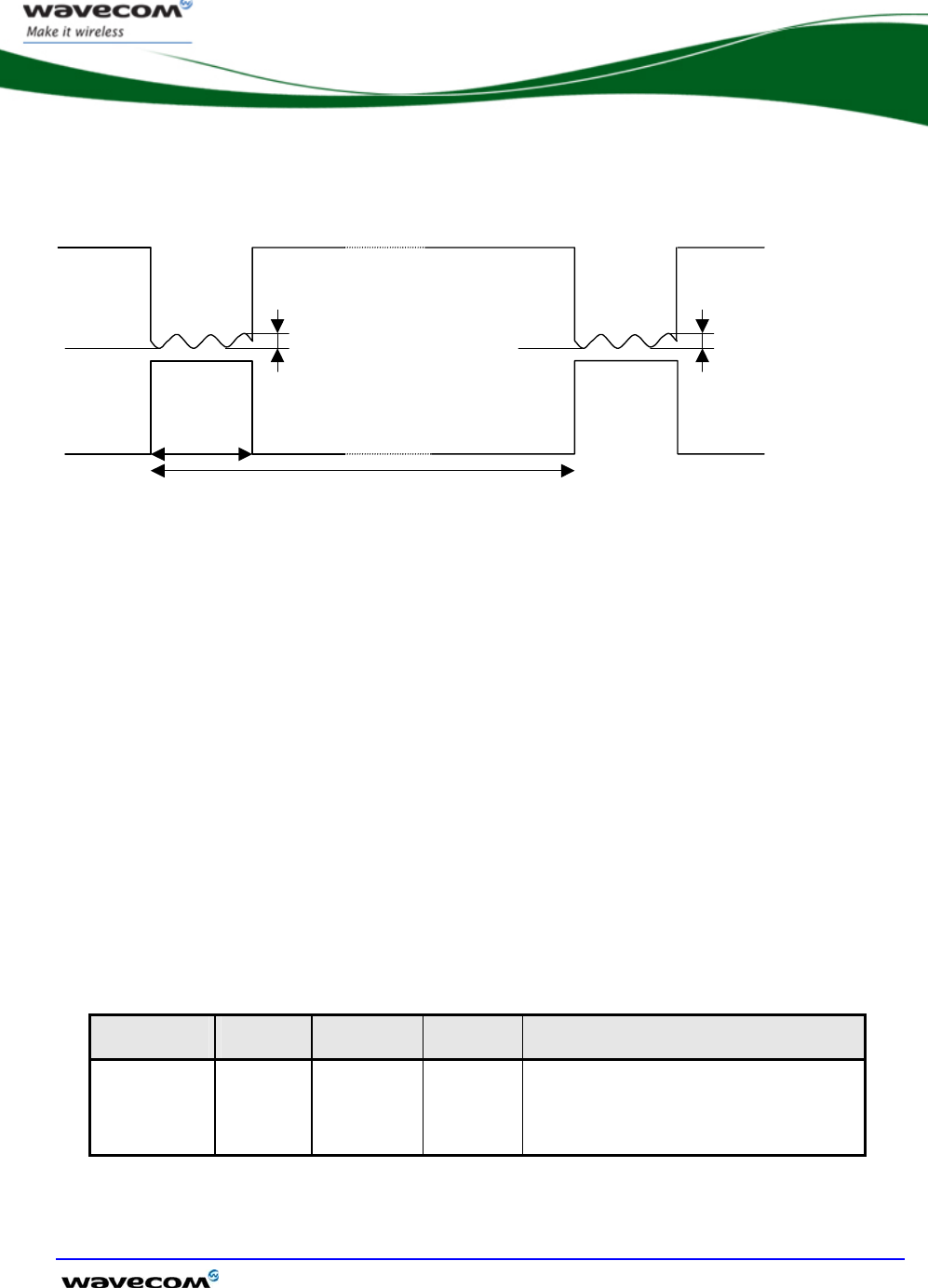
Wireless CPU Quik Q2687
Interfaces
©Confidential Page: 20 / 92
This document is the sole and exclusive property of Wavecom. Not to be distributed or divulged without
prior written agreement.
WA_ENG_Q2687_PTS_001-002 September 11, 2006
In communication mode, a GSM/GPRS class 2 terminal emits 577µs radio bursts
every 4.615ms (See the Figure 2).
Uripp
VBATTT
Uripp
T = 4,615 ms
t = 577 µs
Figure 2: Power supply during burst emission
In communication mode, a GPRS class 10 terminal emits 1154µs radio bursts every
4.615ms.
Only the VBATT power supply input is necessary to provide the Q2687 Wireless CPU.
VBATT:
• Directly supplies the RF components with 3,6 V. It is essential to keep a
minimum voltage ripple at this connection in order to avoid any phase error.
The RF Power Amplifier current (2.0 A peak in GSM /GPRS mode) flows with a
ratio of:
o 1/8 of the time (around 577µs every 4.615ms for GSM /GPRS class 2),
o 2/8 of the time (around 1154µs every 4.615ms for GSM /GPRS class 10)
and
o The rise time is around 10µs.
• Is internally used to provide via several regulators, the VCC_2V8 and VCC_1V8,
the power supply required for the base band signals.
Wireless CPU Quik Q2687 shielding case is the grounding. The ground plane has to
be connected to the motherboard through a complete layer on the PCB.
Input power Supply Voltage
VMIN VNOM VMAX Ripple max (Uripp)
VBATT1,2 3.2 3.6 4.5 250mV (freq < 10kHz)
40mV (10kHz < freq < 100kHz)
5mV (freq > 100kHz)
Table 1 Power supply voltage

Wireless CPU Quik Q2687
Interfaces
©Confidential Page: 21 / 92
This document is the sole and exclusive property of Wavecom. Not to be distributed or divulged without
prior written agreement.
WA_ENG_Q2687_PTS_001-002 September 11, 2006
(1): This value has to be maintained during the burst (with 2.0A Peak in GSM, GPRS
or EGPRS mode)
(2): The maximum operating Voltage Stationary Wave Ratio (VSWR) is 2:1
When supplying the Wireless CPU from a battery, the total impedance (battery +
protections + PCB) should be <150 mOhms.
Caution:
When the Wireless CPU is in Alarm mode, no voltage must be applied on any pin of
the 100-pin connector except on BAT-RTC (pin 7) for RTC operation or ON/~OFF (pin
19) to power ON the Wireless CPU.
3.2.1 Power Consumption
Power consumption is dependent on the configuration used. It is for this reason that
the following consumption values are given for each mode, RF band and type of
software used (AT or Open AT™).
All the following information is given assuming a 50 Ω RF output.
The following consumption values were obtained by performing measurements on
Wireless CPU samples at a temperature of 25° C.
Three VBATT values are used to measure the consumption, VBATTmin (3.2V),
VBATTmax (4.5V) and VBATTtyp (3.6V).
The average current is given for the three VBATT values and the peak current given is
the maximum current peak measured with the three VBATT voltages.
For a more detailed description of the operating modes, see the Appendix of the AT
Command Interface Guide OS 6.61 [4]
For more information about the consumption measurement procedure, see Wireless
CPU Quik Q2687 Customer Design Guidelines [2].
3.2.1.1 Power Consumption without Open AT® Processing
The following measurement results are relevant only when:
¾ There is no Open AT® application
¾ The Open AT® application is disabled
¾ No processing is required by the Open AT® application

Wireless CPU Quik Q2687
Interfaces
©Confidential Page: 22 / 92
This document is the sole and exclusive property of Wavecom. Not to be distributed or divulged without
prior written agreement.
WA_ENG_Q2687_PTS_001-002 September 11, 2006
Power consumption without Open AT® application
Operating mode Parameters IMIN
average
VBATT=4,5V
INOM
average
VBATT=3,6V
IMAX
average
VBATT=3,2V
IMAX
peak unit
Alarm Mode 20.5 17.2 16.2 µA
Paging 9 (Rx burst occurrence ~2s) 14.4 15.3 16.6 160 RX mA
Fast Idle Mode Paging 2 (Rx burst occurrence ~0,5s) 15.6 16.8 17.7 160 RX mA
Paging 9 (Rx burst occurrence ~2s) 1.94 1.84 1.80 160 RX mA
Slow Idle Mode1 Paging 2 (Rx burst occurrence ~0,5s) 4.3 4.4 4.6 160 RX mA
Fast Standby Mode 32.8 37.8 42.4 mA
Slow Standby Mode 1.2 1.1 1.0 mA
PCL5 (TX power 33dBm) 235/235 241/242 240/237 1600
TX mA
850/900 MHz
PCL19 (TX power 5dBm) 87/90 93/96 97/100 350
TX mA
PCL0 (TX power 30dBm) 220/229 226/235 230/239 1500
TX mA
Connected Mode
1800/1900 MHz
PCL15 (TX power 0dBm) 91/91 97/97 101/101 340
TX mA
Gam.3 (TX power
33dBm) 225/226 231/232 230/227 1600
TX mA
850/900 MHz
Gam.17 (TX power
5dBm) 83/86 89/92 93/95 330
TX mA
Gam.3 (TX power
30dBm) 211/219 217/225 220/229 1500
TX mA
Transfer
Mode
class 8
(4Rx/1Tx)
1800/1900 MHz
Gam.18 (TX power
0dBm) 86/87 92/92 96/96 320
TX mA
Gam.3 (TX power
33dBm) 407/406 414/415 408/401 1600
TX mA
850/900 MHz
Gam.17 (TX power
5dBm) 121/126 127/132 131/136 340
TX mA
Gam.3 (TX power
30dBm) 378/392 384/400 388/405 1500
TX mA
GPRS
Transfer
Mode
class 10
(3Rx/2Tx)
1800/1900 MHz
Gam.18 (TX power
0dBm) 127/128 133/134 137/138 330
TX mA
Gam.6 (TX power
27dBm) 161/157 167/163 171/167 1300 TX mA
850/900 MHz
Gam.17 (TX power
5dBm) 90/93 97/100 101/104 400 TX mA
EGPRS Transfer
Mode
class 8
(4Rx/1Tx)
1800/1900 MHz Gam.5 (TX power
26dBm) 167/172 173/178 177/183 1400 TX mA

Wireless CPU Quik Q2687
Interfaces
©Confidential Page: 23 / 92
This document is the sole and exclusive property of Wavecom. Not to be distributed or divulged without
prior written agreement.
WA_ENG_Q2687_PTS_001-002 September 11, 2006
Power consumption without Open AT® application
Operating mode Parameters IMIN
average
VBATT=4,5V
INOM
average
VBATT=3,6V
IMAX
average
VBATT=3,2V
IMAX
peak unit
Gam.18 (TX power
0dBm) 93/94 100/100 104/104 400 TX mA
Gam.6 (TX power
27dBm) 278/270 285/277 290/282 1300 TX mA
850/900 MHz
Gam.17 (TX power
5dBm) 134/140 142/147 146/152 420 TX mA
Gam.5 (TX power
26dBm) 291/303 298/310 302/314 1400 TX mA
Transfer
Mode
class 10
(3Rx/2Tx)
1800/1900 MHz
Gam.18 (TX power
0dBm) 141/142 148/149 153/154 420 TX mA
TX means: the current peak is RF transmission burst (Tx burst)
RX means: the current peak is RF reception burst (Rx burst)
1 Slow Idle Mode consumption is dependent on the SIM card used. Some SIM cards
respond faster than others, the longer the response time, the higher the
consumption. The measurements were performed on a large number of 3V SIM
cards, and the results shown in the above table in brackets are the minimum and
maximum currents measured from the SIM cards used.
3.2.1.2 Power Consumption with Open AT® Software
The power consumption with Open AT® software used is Dhrystone application, and
the following consumption results were measured while performing on the Dhrystone
application.
Power consumption with Dhrystone Open AT® application
Operating mode Parameters IMIN
average
VBATT=4,5V
INOM
average
VBATT=3,6V
IMAX
average
VBATT=3,2V
IMAX
peak unit
Alarm Mode N/A N/A N/A µA
Paging 9 (Rx burst occurrence ~2s)
33 38 41 160
RX mA
Fast Idle Mode
Paging 2 (Rx burst occurrence ~0,5s) 33 38 42 160
RX mA
Paging 9 (Rx burst occurrence ~2s) NA NA NA NA mA
Slow Idle Mode
Paging 2 (Rx burst occurrence ~0,5s) NA NA NA NA mA
Fast Standby Mode 32 38 40 mA
Slow Standby Mode NA NA NA mA

Wireless CPU Quik Q2687
Interfaces
©Confidential Page: 24 / 92
This document is the sole and exclusive property of Wavecom. Not to be distributed or divulged without
prior written agreement.
WA_ENG_Q2687_PTS_001-002 September 11, 2006
Power consumption with Dhrystone Open AT® application
Operating mode Parameters IMIN
average
VBATT=4,5V
INOM
average
VBATT=3,6V
IMAX
average
VBATT=3,2V
IMAX
peak unit
PCL5 (TX power 33dBm) 235/235 241/242 240/237 1600
TX mA
850/900 MHz
PCL19 (TX power 5dBm) 87/90 93/96 97/100 350
TX mA
PCL0 (TX power 30dBm) 220/229 226/235 230/239 1500
TX mA
Connected Mode
1800/1900 MHz
PCL15 (TX power 0dBm) 91/91 97/97 101/101 340
TX mA
Gam.3 (TX power
33dBm) 225/226 231/232 230/227 1600
TX mA
850/900 MHz
Gam.17 (TX power
5dBm) 83/86 89/92 93/95 330
TX mA
Gam.3 (TX power
30dBm) 211/219 217/225 220/229 1500
TX mA
Transfer
Mode
class 8
(4Rx/1Tx)
1800/1900 MHz
Gam.18 (TX power
0dBm) 86/87 92/92 96/96 320
TX mA
Gam.3 (TX power
33dBm) 407/406 414/415 408/401 1600
TX mA
850/900 MHz
Gam.17 (TX power
5dBm) 121/126 127/132 131/136 340
TX mA
Gam.3 (TX power
30dBm) 378/392 384/400 388/405 1500
TX mA
GPRS
Transfer
Mode
class 10
(3Rx/2Tx)
1800/1900 MHz
Gam.18 (TX power
0dBm) 127/128 133/134 137/138 330
TX mA
Gam.6 (TX power
27dBm) 161/157 167/163 171/167 1300 TX mA
850/900 MHz
Gam.17 (TX power
5dBm) 90/93 97/100 101/104 400 TX mA
Gam.5 (TX power
26dBm) 167/172 173/178 177/183 1400 TX mA
Transfer
Mode
class 8
(4Rx/1Tx)
1800/1900 MHz
Gam.18 (TX power
0dBm) 93/94 100/100 104/104 400 TX mA
Gam.6 (TX power
27dBm) 278/270 285/277 290/282 1300 TX mA
850/900 MHz
Gam.17 (TX power
5dBm) 134/140 142/147 146/152 420 TX mA
Gam.5 (TX power
26dBm) 291/303 298/310 302/314 1400 TX mA
EGPRS
Transfer
Mode
class 10
(3Rx/2Tx)
1800/1900 MHz
Gam.18 (TX power
0dBm) 141/142 148/149 153/154 420 TX mA
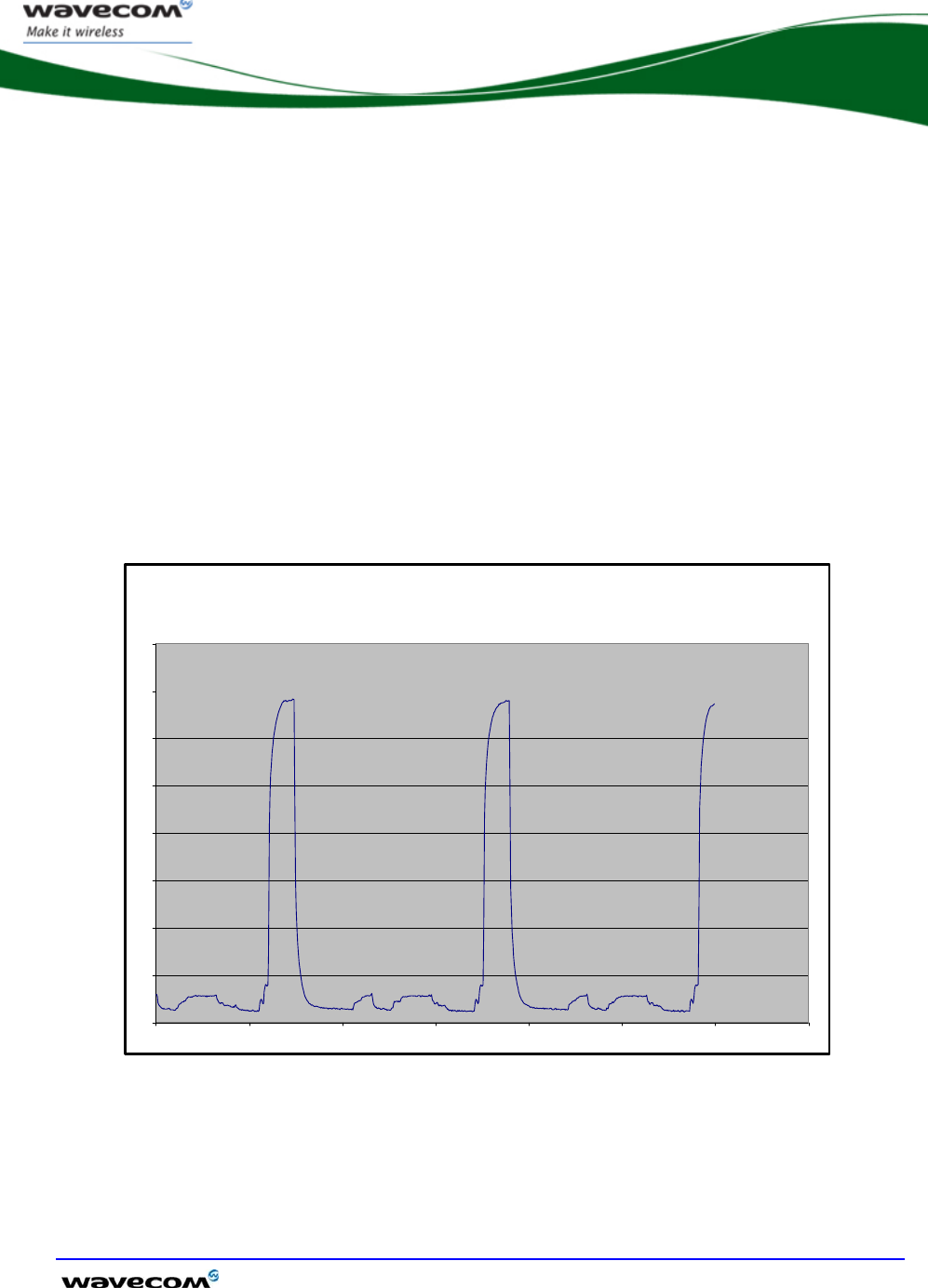
Wireless CPU Quik Q2687
Interfaces
©Confidential Page: 25 / 92
This document is the sole and exclusive property of Wavecom. Not to be distributed or divulged without
prior written agreement.
WA_ENG_Q2687_PTS_001-002 September 11, 2006
3.2.1.3 Consumption Waveform Samples
The consumption waveforms are given for a EGSM900 network configuration with
AT software running on the Q2687/X61 Wireless CPU.
The VBATT voltage value is 3.6V typical.
Four significant operating mode consumption waveforms are described as:
¾ Connected Mode (PCL5: Tx power 33dBm)
¾ Slow Idle mode (Paging 9)
¾ Fast idle mode (Paging 9)
¾ Transfer mode (GPRS class 10, PCL3: Tx power 33dBm)
The following waveform displays only the form of the current and for correct current
values, see the section 3.2.1.1.
3.2.1.3.1 Connected Mode Current Waveform
Connected mode 33dBm
Current (A) / Time (s)
0
0.2
0.4
0.6
0.8
1
1.2
1.4
1.6
0 0.002 0.004 0.006 0.008 0.01 0.012 0.014
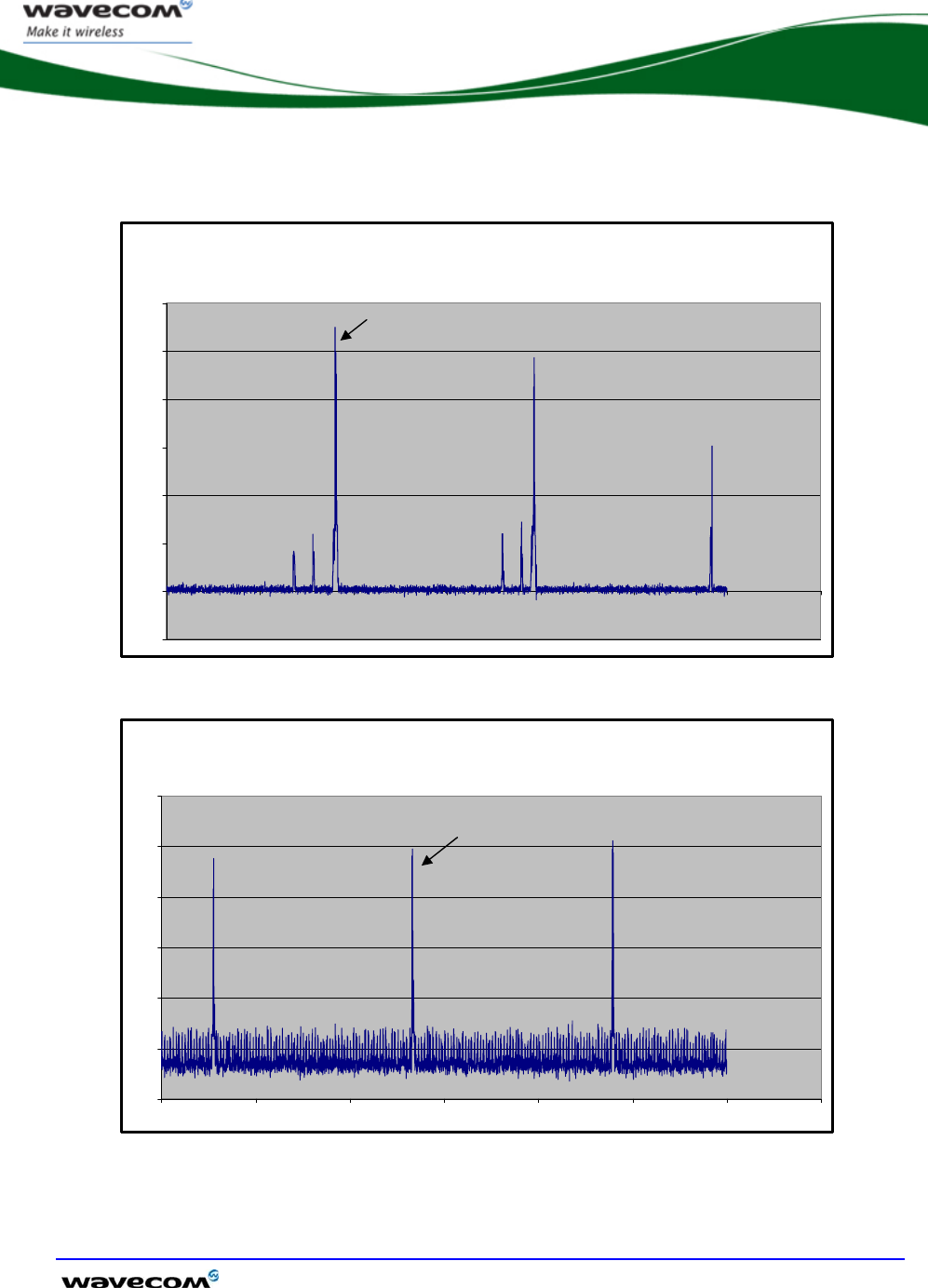
Wireless CPU Quik Q2687
Interfaces
©Confidential Page: 26 / 92
This document is the sole and exclusive property of Wavecom. Not to be distributed or divulged without
prior written agreement.
WA_ENG_Q2687_PTS_001-002 September 11, 2006
3.2.1.3.2 Slow Idle Mode Current Waveform
Slow Idle mode Paging ~2s
Current (A) / Time (s)
-0.02
0
0.02
0.04
0.06
0.08
0.1
0.12
01234567
3.2.1.3.3 Fast Idle Mode Current Waveform
Fast Idle mode Paging ~2s
Current (A) / Time (s)
0
0.02
0.04
0.06
0.08
0.1
0.12
01234567
RX Peak
RX Peak
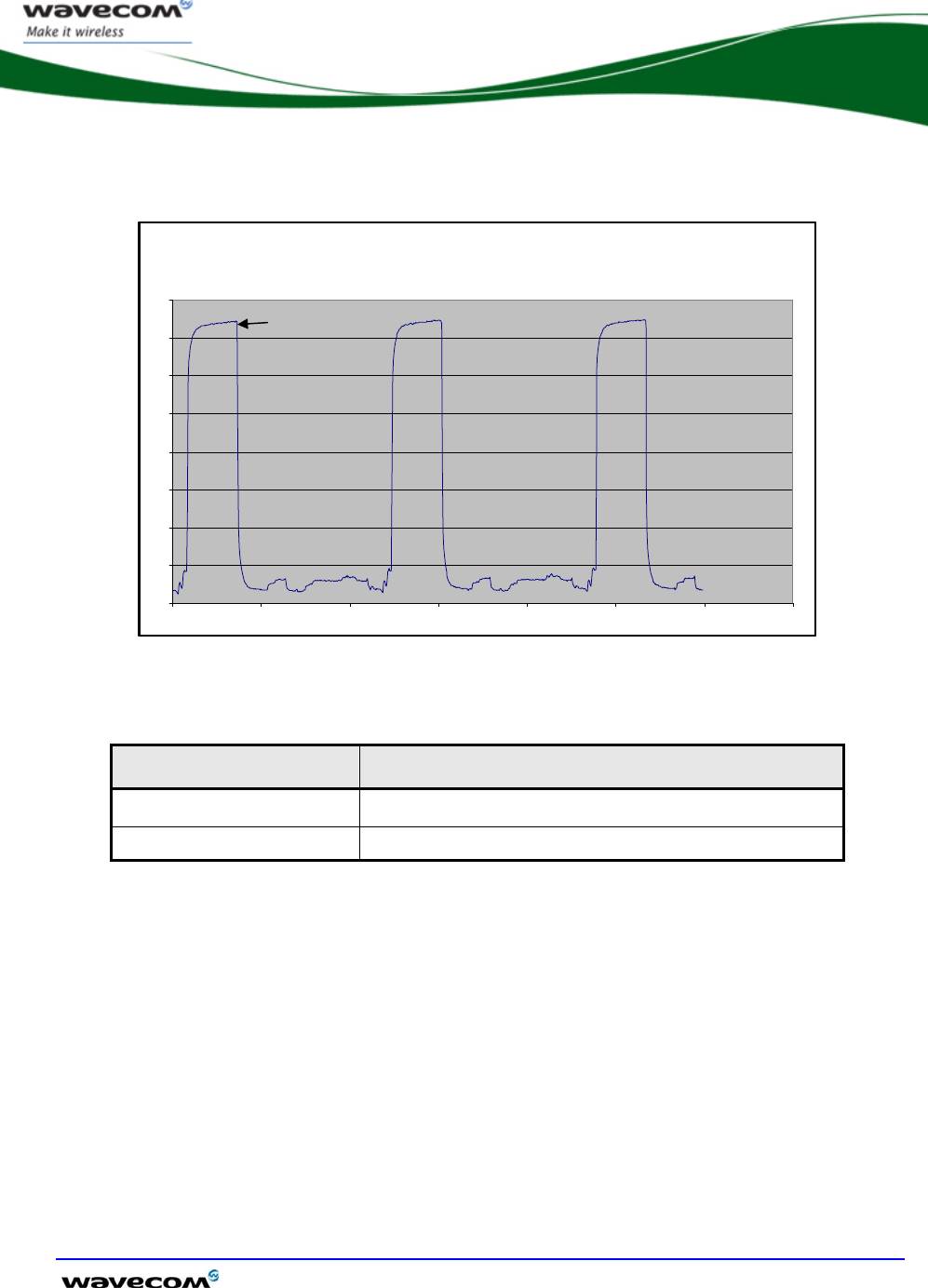
Wireless CPU Quik Q2687
Interfaces
©Confidential Page: 27 / 92
This document is the sole and exclusive property of Wavecom. Not to be distributed or divulged without
prior written agreement.
WA_ENG_Q2687_PTS_001-002 September 11, 2006
3.2.1.3.4 Transfer Mode Class 10 Current Waveform
Transfer mode Class 10 33dBm
Current (A) / Time (s)
0
0.2
0.4
0.6
0.8
1
1.2
1.4
1.6
0 0.002 0.004 0.006 0.008 0.01 0.012 0.014
3.2.1.4 Power Supply Pin-out
Power Supply Pin-out
Signal Pin number
VBATT 1,2,3,4
GND Shielding
The grounding connection is made through the shielding Ö the four leads must be
soldered to the ground plane.
TX Peak

Wireless CPU Quik Q2687
Interfaces
©Confidential Page: 28 / 92
This document is the sole and exclusive property of Wavecom. Not to be distributed or divulged without
prior written agreement.
WA_ENG_Q2687_PTS_001-002 September 11, 2006
3.3 Electrical Information for Digital I/O
The three types of digital I/O on the Wireless CPU Quik Q2687 are: 2.8Volt CMOS,
1.8Volt CMOS, and Open drain.
The three types are as described below:
Electrical characteristics of digital I/O
2.8 Volt type (2V8 )
Parameter I/O type Min. Typ Max. Condition
Internal 2.8V power supply VCC_2V8 2.74V 2.8V 2.86V
VIL CMOS -0.5V* 0.84V
VIH CMOS 1.96V 3.2V*
VOL CMOS 0.4V IOL = - 4 mA
VOH CMOS 2.4V IOH = 4 mA
IOH 4mA
Input / Output pin
IOL - 4mA
*Absolute maximum ratings
All 2.8V I/O pins do not accept input signal voltage above the maximum voltage as
specified in the above table, except for the UART1 interface, which is 3.3V tolerant.
1.8 Volt type (1V8)
Parameter I/O type Min. Typ Max. Condition
Internal 1V8 power supply VCC_1V8 1.76V 1.8V 1.94V
VIL CMOS -0.5V* 0.54V
VIH CMOS 1.33V 2.2V*
VOL CMOS 0.4V IOL = - 4 mA
VOH CMOS 1.4V IOH = 4 mA
IOH 4mA
Input / Output pin
IOL - 4mA
*Absolute maximum ratings

Wireless CPU Quik Q2687
Interfaces
©Confidential Page: 29 / 92
This document is the sole and exclusive property of Wavecom. Not to be distributed or divulged without
prior written agreement.
WA_ENG_Q2687_PTS_001-002 September 11, 2006
Open drain output type
Signal name Parameter I/O type Minimum Typ Maximum Condition
VOL Open Drain 0.4V
FLASH-LED
IOL Open Drain 8mA
VOL Open Drain 0.4V BUZZ-OUT
IOL Open Drain 100mA
VTOL Open Drain 3.3V Tolerated
voltage
VIH Open Drain 2V
VIL Open Drain 0.8V
VOL Open Drain 0.4V
SDA /
GPIO27
and
SCL /
GPIO26
IOL Open Drain 3mA
The I/Os reset states are described in each interface description chapter. Definitions of
these states are as given below:
Reset state definition
Parameter Definition
0 Set to GND
1 Set to supply 1V8 or 2V8 depending on I/O type
Pull-down Internal pull-down with ~60K resistor.
Pull-up Internal pull-up with ~60K resistor to supply 1V8 or 2V8
depending on I/O type.
Z High impedance
Undefined Caution: undefined must not be used in your application if a
special state is required at reset. These pins may be a
toggling signal during reset.

Wireless CPU Quik Q2687
Interfaces
©Confidential Page: 30 / 92
This document is the sole and exclusive property of Wavecom. Not to be distributed or divulged without
prior written agreement.
WA_ENG_Q2687_PTS_001-002 September 11, 2006
3.4 Serial Interface
The Wireless CPU Quik Q2687 may be connected to an LCD Wireless CPU driver
through either by two SPI bus or an I²C 2-wire interface.
3.4.1 SPI Bus
Both SPI bus interfaces include:
• A CLK signal
• An I/O signal
• An I signal
• A CS signal complying with the standard SPI bus.
SPI bus characteristics:
• Master mode operation
• SPI speed ranges from 101.5 Kbit/s to 13 Mbit/s in master mode operation
• 3 or 4-wire interface
• SPI-mode configuration: 0 to 3
• 1 to 16 bits data length
3.4.1.1 SPI Waveforms
Waveform for SPI transfer with 4-wire configuration in master mode 0 (chip selection
is not displayed).
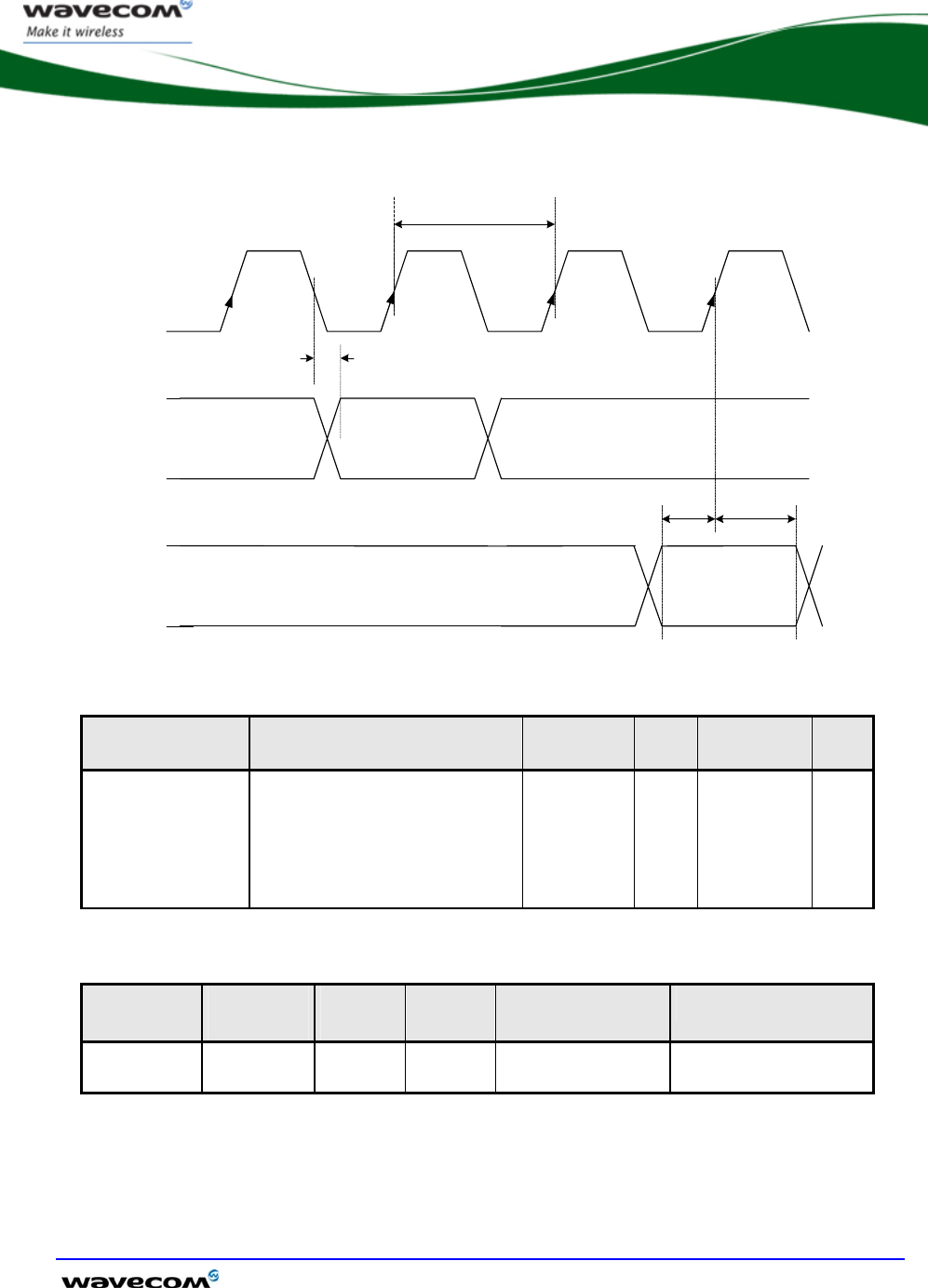
Wireless CPU Quik Q2687
Interfaces
©Confidential Page: 31 / 92
This document is the sole and exclusive property of Wavecom. Not to be distributed or divulged without
prior written agreement.
WA_ENG_Q2687_PTS_001-002 September 11, 2006
Data-OUTdelay
CLK-cycle
Data-IN-hold
Data-IN-setup
SPIx-IO
Data valid
Data valid
SPIx-CLK
SPIx-I
Figure 3: SPI Timing diagrams, Mode 0, Master, and 4-wire
AC characteristics
Signal Description Minimum Typ Maximum Unit
CLK-cycle SPI clock frequency 0.1015 13 MHz
Data-OUT delay Data out ready delay time 10 ns
Data-IN-setup Data in setup time 2 ns
Data-OUT-hold Data out hold time 2 ns
3.4.1.2 SPI Configuration
Operation Maximum
Speed
SPI-
Mode
Duplex 3-wire type 4-wire type
Master 13 Mb/s 0,1,2,3 Half SPIx-CLK; SPIx-
IO; ~SPIx-CS
SPIx-CLK; SPIx-IO;
SPIx-I; ~SPIx-CS
For the 4-wire configuration, SPIx-I/O is used as output only and SPIx-I is used as input only.
For the 3-wire configuration, SPIx-I/O is used for both as input and output.
3.4.1.3 SPI1 Bus
Pin description

Wireless CPU Quik Q2687
Interfaces
©Confidential Page: 32 / 92
This document is the sole and exclusive property of Wavecom. Not to be distributed or divulged without
prior written agreement.
WA_ENG_Q2687_PTS_001-002 September 11, 2006
Signal Pin
number
I/O I/O
type
Reset
state
Description Multiplexed
with
SPI1-CLK 23 O 2V8 Z SPI Serial Clock GPIO28
SPI1-IO 25 I/O 2V8 Z SPI Serial input/output GPIO29
SPI1-I 24 I 2V8 Z SPI Serial input GPIO30
~SPI1-CS 22 O 2V8 Z SPI Enable GPIO31
For Open drain, 2V8 and 1V8 voltage characteristics and Reset state definition, refer to section 3.3,
"Electrical information for digital I/O".
3.4.1.4 SPI2 Bus
Pin description
Signal Pin
number
I/O I/O
type
Reset
state
Description Multiplexed
with
SPI2-CLK 26 O 2V8 Z SPI Serial Clock GPIO32
SPI2-IO 27 I/O 2V8 Z SPI Serial input/output GPIO33
SP2-I 29 I 2V8 Z SPI Serial input GPIO34
~SPI2-CS 28 O 2V8 Z SPI Enable GPIO35
See section 3.3 "Electrical information for digital I/O" for Open drain, 2V8 and 1V8 voltage characteristics
and Reset state definition.
3.4.2 I²C bus
The I²C interface includes a clock signal (SCL) and data signal (SDA) complying with a
100Kbit/s-standard interface (standard mode: s-mode).
The I²C bus is always in master mode.
The maximum speed transfer range is 400Kbit/s (fast mode: f-mode).
For more information on the I²C bus, see the "I²C Bus Specification Version 2.0" from
PHILIPS.
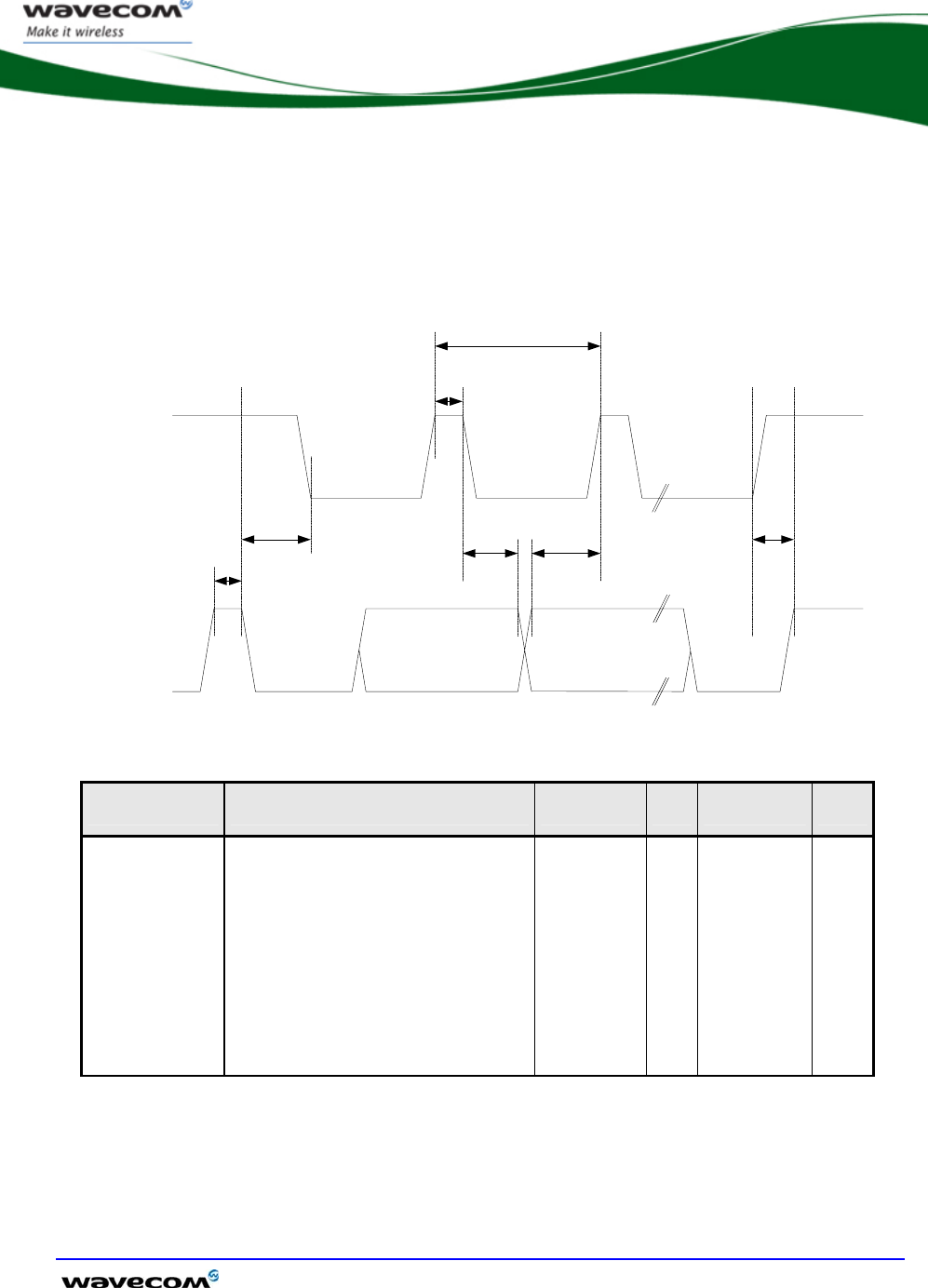
Wireless CPU Quik Q2687
Interfaces
©Confidential Page: 33 / 92
This document is the sole and exclusive property of Wavecom. Not to be distributed or divulged without
prior written agreement.
WA_ENG_Q2687_PTS_001-002 September 11, 2006
3.4.2.1 I²C Waveforms
I²C bus waveform in master mode configuration:
Data valid
SCL
SDA
Data valid
T-free
T-start
T-high
T-data-
setup
T-data-
hold
T-stop
SCL-freq
Figure 4: I²C Timing diagrams, Master
AC characteristics
Signal Description Minimum Typ Maximum Unit
SCL-freq I²C clock frequency 100 400 KHz
T-start Hold time START condition 0.6 µs
T-stop Setup time STOP condition 0.6 µs
T-free Bus free time, STOP to START 1.3 µs
T-high High period for clock 0.6 µs
T-data-hold Data hold time 0 0.9 µs
T-data-setup Data setup time 100 ns
3.4.2.2 I²C Bus pin-out

Wireless CPU Quik Q2687
Interfaces
©Confidential Page: 34 / 92
This document is the sole and exclusive property of Wavecom. Not to be distributed or divulged without
prior written agreement.
WA_ENG_Q2687_PTS_001-002 September 11, 2006
Pin description
Signal Pin
number
I/O I/O type Reset
state
Description Multiplexed
with
SCL 44 O Open drain Z Serial Clock GPIO26
SDA 46 I/O Open drain Z Serial Data GPIO27
See section 3.3, "Electrical information for digital I/O" for Open drain, 2V8 and 1V8 voltage characteristics
and Reset state definition.
3.5 Parallel Interface
The Wireless CPU Quik Q2687 offers a 16-bit wide parallel bus interface.
Few signals are multiplexed. It is possible to have these configurations.
For software information, see the document [4].
• CS3*, A1, GPIO1, GPIO2
• CS3*, A1, A24, GPIO1
• CS3*, A1, A24, A25
• CS3*, CS2*, A1, GPIO2
• CS3*, CS2*, A1, A24

Wireless CPU Quik Q2687
Interfaces
©Confidential Page: 35 / 92
This document is the sole and exclusive property of Wavecom. Not to be distributed or divulged without
prior written agreement.
WA_ENG_Q2687_PTS_001-002 September 11, 2006
Signal Pin
number
Reset
state
I/O I/O type Description Multiplexed
with
D0 85 Pull down I/O
1v8 Data bus Not mux
D1 87 Pull down I/O
1v8 Data bus Not mux
D2 89 Pull down I/O
1v8 Data bus Not mux
D3 91 Pull down I/O
1v8 Data bus Not mux
D4 93 Pull down I/O
1v8 Data bus Not mux
D5 95 Pull down I/O
1v8 Data bus Not mux
D6 97 Pull down I/O
1v8 Data bus Not mux
D7 99 Pull down I/O
1v8 Data bus Not mux
D8 100 Pull down I/O
1v8 Data bus Not mux
D9 98 Pull down I/O
1v8 Data bus Not mux
D10 96 Pull down I/O
1v8 Data bus Not mux
D11 94 Pull down I/O
1v8 Data bus Not mux
D12 92 Pull down I/O
1v8 Data bus Not mux
D13 90 Pull down I/O
1v8 Data bus Not mux
D14 88 Pull down I/O
1v8 Data bus Not mux
D15 86 Pull down I/O
1v8 Data bus Not mux
/OE-R/W 81 1 O
1v8 Read Operation Not mux
/WE-E 84 1 O
1v8 Write Operation Not mux
/CS3 83 1 O
1v8 User Chip select Not mux
/CS2 51 Undefined I/O
1v8 User Chip Select A25/GPIO1
A1 42 1 O
1v8 Address bus 1 Not mux
A24 53 Undefined I/O
1v8 Data/Command
selection
GPIO2
3.6 Keyboard Interface
This interface provides 10 connections:
• 5 rows (ROW0 to ROW4) and
• 5 columns (COL0 to COL4).
Scanning is digital and debouncing is performed in the Wireless CPU Quik Q2687.
No discrete components such as Rs, Cs (Resistors, Capacitors) are needed.

Wireless CPU Quik Q2687
Interfaces
©Confidential Page: 36 / 92
This document is the sole and exclusive property of Wavecom. Not to be distributed or divulged without
prior written agreement.
WA_ENG_Q2687_PTS_001-002 September 11, 2006
Pin description of the Keyboard interface
Signal Pin
number
I/O I/O
type
Reset
state
Description Multiplexed
with
ROW0 68 I/O 1V8 0 Row scan GPIO9
ROW1 67 I/O
1V8 0 Row scan GPIO10
ROW2 66 I/O
1V8 0 Row scan GPIO11
ROW3 65 I/O
1V8 0 Row scan GPIO12
ROW4 64 I/O
1V8 0 Row scan GPIO13
COL0 59 I/O
1V8 Pull-up Column scan GPIO4
COL1 60 I/O
1V8 Pull-up Column scan GPIO5
COL2 61 I/O
1V8 Pull-up Column scan GPIO6
COL3 62 I/O
1V8 Pull-up Column scan GPIO7
COL4 63 I/O
1V8 Pull-up Column scan GPIO8
See section 3.3, "Electrical information for digital I/O" for Open drain, 2V8 and 1V8 voltage characteristics
and for Reset state definition.
3.7 Main Serial Link (UART1)
A flexible 6-wire serial interface is available, complies with V24 protocol signaling,
but not with V28 (electrical interface) due to a 2.8-Volt interface.
The signals are as follows:
• TX data (CT103/TX)
• RX data (CT104/RX)
• Request To Send (~CT105/RTS)
• Clear To Send (~CT106/CTS)
• Data Terminal Ready (~CT108-2/DTR)
• Data Set Ready (~CT107/DSR).
The set of RS-232 signals may be required for GSM DATA services application and is
generated by the General Purpose I/O provided by the Wireless CPU Quik Q2687.
The two additional signals are:
• Data Carrier Detect (~CT109/DCD) and
• Ring Indicator (CT125/RI).

Wireless CPU Quik Q2687
Interfaces
©Confidential Page: 37 / 92
This document is the sole and exclusive property of Wavecom. Not to be distributed or divulged without
prior written agreement.
WA_ENG_Q2687_PTS_001-002 September 11, 2006
Pin description of UART1 interface
See Section "3.3 Electrical information for digital I/O" for Open drain, 2V8 and 1V8 voltage characteristics
and for Reset state definition.
*According to PC view
The rise and fall time of the reception signals (mainly due to CT103) must be less
than 300 ns.
The Q2687 Wireless CPU is designed to operate using all the serial interface signals.
In particular, it is mandatory to use RTS and CTS for hardware flow control in order
to avoid data corruption during transmission.
The maximum baud rate of UART1 is 115 Kbit/s.
Signal Pin
number
I/O I/O
type
Reset
state
Description Multiplexed
with
CT103/TXD1* 71 I 2V8 Z Transmit serial
data
GPIO36
CT104/RXD1* 73 O
2V8 1 Receive serial
data
GPIO37
~CT105/RTS1* 72 I
2V8 Z Request To
Send
GPIO38
~CT106/CTS1* 75 O
2V8 Z Clear To Send GPIO39
~CT107/DSR1* 74 O
2V8 Z Data Set Ready GPIO40
~CT108-
2/DTR1*
76 I
2V8 Z Data Terminal
Ready
GPIO41
~CT109/DCD1 * 70 O 2V8 Undefined Data Carrier
Detect
GPIO43
~CT125/RI1 * 69 O 2V8 Undefined Ring Indicator GPIO42
CT102/GND* Shielding
leads
GND Ground

Wireless CPU Quik Q2687
Interfaces
©Confidential Page: 38 / 92
This document is the sole and exclusive property of Wavecom. Not to be distributed or divulged without
prior written agreement.
WA_ENG_Q2687_PTS_001-002 September 11, 2006
3.8 Auxiliary Serial Link (UART2)
The Bluetooth application on auxiliary serial interface (UART2) is available on Wireless
CPU Quik Q2687 product. See the Application Note WM_ASW_AOT_APN_016 and the
document [4].
Pin description of UART2 interface
Signal Pin
number
I/O I/O type Reset
state
Description Multiplexed
with
CT103 /
TXD2*
31 I 1V8 Z Transmit serial data GPIO14
CT104 /
RXD2*
30 O 1V8 Z Receive serial data GPIO15
~CT106 /
CTS2*
32 O 1V8 Z Clear To Send GPIO16
~CT105 /
RTS2*
33 I 1V8 Z Request To Send GPIO17
See Section 3.3, "Electrical information for digital I/O" for Open drain, 2V8 and 1V8 voltage characteristics
and Reset state definition.
* According to PC view
The Q2687 is designed to operate using all the serial interface signals. In particular, it
is mandatory to use RTS and CTS for hardware flow control in order to avoid data
corruption during transmission.
The maximum baud rate of UART2 is 115 Kbit/s.
3.9 SIM Interface
The Subscriber Identification Module (SIM) may be directly connected to the Wireless
CPU Quik Q2687 via this dedicated interface.
3.9.1 General Description
The five signals are:
• SIM-VCC: SIM power supply
• ~SIM-RST: reset
• SIM-CLK: clock
• SIM-IO: I/O port
• SIMPRES: SIM card detect
The SIM interface controls a 3V/1V8 SIM. This interface is fully compliant with the
GSM 11.11 recommendations related to SIM functions.

Wireless CPU Quik Q2687
Interfaces
©Confidential Page: 39 / 92
This document is the sole and exclusive property of Wavecom. Not to be distributed or divulged without
prior written agreement.
WA_ENG_Q2687_PTS_001-002 September 11, 2006
Pin description of SIM interface
Signal Pin
number
I/O I/O type Reset
state
Description Multiplexed
with
SIM-CLK 14 O 2V9 / 1V8 0 SIM Clock Not mux
~SIM-RST 13 O
2V9 / 1V8 0 SIM Reset
Not mux
SIM-IO 11 I/O
2V9 / 1V8 *Pull-up SIM Data Not mux
SIM-VCC 9 O
2V9 / 1V8 SIM Power
Supply
Not mux
SIMPRES 12 I 1V8 Z SIM Card
Detect
GPIO18
*SIM-IO pull-up is about 10K ohm
See Section 3.3 "Electrical information for digital I/O" for Open drain, 2V8 and 1V8 voltage characteristics
and Reset state definition.

Wireless CPU Quik Q2687
Interfaces
©Confidential Page: 40 / 92
This document is the sole and exclusive property of Wavecom. Not to be distributed or divulged without
prior written agreement.
WA_ENG_Q2687_PTS_001-002 September 11, 2006
Electrical Characteristics of the SIM interface
Parameter Conditions Min. Typ Max. Unit
SIM-IO VIH IIH = ± 20µA 0.7xSIMVCC V
SIM-IO VIL I
IL = 1mA 0.4 V
~SIM-RST, SIM-CLK
VOH
Source current = 20µA 0.9xSIMVCC V
SIM-IO VOH Source current = 20µA 0.8xSIMVCC
~SIM-RST, SIM-IO, SIM-
CLK
VOL
Sink current =
-200µA
0.4 V
SIMVCC = 2.9V
IVCC= 1mA
2.84 2.9 2.96 V SIM-VCC Output Voltage
SIMVCC = 1.8V
IVCC= 1mA
1.74 1.8 1.86 V
SIM-VCC current VBATT = 3.6V 10 mA
SIM-CLK Rise/Fall Time Loaded with 30pF 20 ns
~SIM-RST, Rise/Fall Time Loaded with 30pF 20 ns
SIM-IO Rise/Fall Time Loaded with 30pF 0.7 1 µs
SIM-CLK Frequency Loaded with 30pF 3.25 MHz
Note:
When SIMPRES is used, a low to high transition means that the SIM card is inserted
and a high to low transition means that the SIM card is removed.

Wireless CPU Quik Q2687
Interfaces
©Confidential Page: 41 / 92
This document is the sole and exclusive property of Wavecom. Not to be distributed or divulged without
prior written agreement.
WA_ENG_Q2687_PTS_001-002 September 11, 2006
3.10 General Purpose Input/Output
The Wireless CPU Quik Q2687 provides up to 44 General Purpose I/O. They are used
to control any external device such as a LCD or a Keyboard backlight.
All grey highlighted I/O are 1V8 whereas the others (not highlighted in grey) are 2V8.
Pin description of the GPIO
Signal Pin
number I/O I/O type* Reset state Multiplexed with
GPIO1 51 I/O 1V8 Undefined A25/~CS2*
GPIO2 53 I/O 1V8 Undefined A24*
GPIO3 50 I/O 1V8 Z INT0
GPIO4 59 I/O 1V8 Pull up COL0
GPIO5 60 I/O 1V8 Pull up COL1
GPIO6 61 I/O 1V8 Pull up COL2
GPIO7 62 I/O 1V8 Pull up COL3
GPIO8 63 I/O 1V8 Pull up COL4
GPIO9 68 I/O 1V8 0 ROW0
GPIO10 67 I/O 1V8 0 ROW1
GPIO11 66 I/O 1V8 0 ROW2
GPIO12 65 I/O 1V8 0 ROW3
GPIO13 64 I/O 1V8 0 ROW4
GPIO14 31 I/O 1V8 Z CT103 / TXD2
GPIO15 30 I/O 1V8 Z CT104 / RXD2
GPIO16 32 I/O 1V8 Z ~CT106 / CTS2
GPIO17 33 I/O 1V8 Z ~CT105 / RTS2
GPIO18 12 I/O 1V8 Z SIMPRES
GPIO19 45 I/O 2V8 Z Not mux
GPIO20 48 I/O 2V8 Undefined Not mux
GPIO21 47 I/O 2V8 Undefined Not mux
GPIO22 57 I/O 2V8 Z Not mux**
GPIO23 55 I/O 2V8 Z Not mux**

Wireless CPU Quik Q2687
Interfaces
©Confidential Page: 42 / 92
This document is the sole and exclusive property of Wavecom. Not to be distributed or divulged without
prior written agreement.
WA_ENG_Q2687_PTS_001-002 September 11, 2006
Signal Pin
number I/O I/O type* Reset state Multiplexed with
GPIO24 58 I/O 2V8 Z Not mux
GPIO25 49 I/O 2V8 Z INT1
GPIO26 44 I/O
Open
drain
Z SCL
GPIO27 46 I/O
Open
drain
Z SDA
GPIO28 23 I/O 2V8 Z SPI1-CLK
GPIO29 25 I/O 2V8 Z SPI1-IO
GPIO30 24 I/O 2V8 Z SP1-I
GPIO31 22 I/O 2V8 Z ~SPI1-CS
GPIO32 26 I/O 2V8 Z SPI2-CLK
GPIO33 27 I/O 2V8 Z SPI2-IO
GPIO34 29 I/O 2V8 Z SP2-I
GPIO35 28 I/O 2V8 Z ~SPI2-CS
GPIO36 71 I/O 2V8 Z CT103 / TXD1
GPIO37 73 I/O 2V8 1 CT104 / RXD1
GPIO38 72 I/O 2V8 Z ~CT105 / RTS1
GPIO39 75 I/O 2V8 Z ~CT106 / CTS1
GPIO40 74 I/O 2V8 Z ~CT107 / DSR1
GPIO41 76 I/O 2V8 Z ~CT108-2 / DTR1
GPIO42 69 I/O 2V8 Undefined ~CT125 / RI1
GPIO43 70 I/O 2V8 Undefined ~CT109 / DCD1
GPIO44 43 I/O 2V8 Undefined Not mux
See Section "3.3 Electrical information for digital I/O" for Open drain, 2V8 and 1V8 voltage characteristics
and for Reset state definition.
* If the parallel bus is used, these pins will be mandatory for the parallel bus functionality. See "Section
3.5"
** If a Bluetooth module is used with the Q2687 Wireless CPU, this GPIO must be reserved.

Wireless CPU Quik Q2687
Interfaces
©Confidential Page: 43 / 92
This document is the sole and exclusive property of Wavecom. Not to be distributed or divulged without
prior written agreement.
WA_ENG_Q2687_PTS_001-002 September 11, 2006
3.11 Analog to Digital Converter
Two Analog to Digital Converter (ADC) inputs are provided by the Wireless CPU Quik
Q2687. The converters are 10-bit resolution, ranges from 0V to 2V.
Pin description of the ADC
Signal Pin number I/O I/O type Description
BAT-TEMP* 20 I Analog A/D converter
AUX-ADC 21 I Analog A/D converter
This input is reserved for a battery charging temperature sensor,
see Section 3.16, "Battery Charging interface".
Electrical Characteristics of the ADC
Parameter Min Typ Max Unit
Resolution 10 bits
Sampling rate 138¹ sps
Input signal range 0 2 V
INL (Integral non linearity) 15 mV
DNL (Differential non
linearity)
2.5 mV
BAT-TEMP 1M*
Ω
Input
impedance
AUX-ADC 1M
Ω
* Internal pull-up to 2.8V
1 Sampling rate only for AUX-ADC and Open AT® application

Wireless CPU Quik Q2687
Interfaces
©Confidential Page: 44 / 92
This document is the sole and exclusive property of Wavecom. Not to be distributed or divulged without
prior written agreement.
WA_ENG_Q2687_PTS_001-002 September 11, 2006
3.12 Digital to Analog Converter
One Digital to Analog Converter (DAC) input is provided by the Q2687 Wireless CPU.
The converter is 8-bit resolution, ranges from 0V to 2.3V.
Pin description of the DAC
Signal Pin number I/O I/O type Description
AUX-DAC 82 O Analog D/A converter
This output assumes a typical external load of 2kΩ and 50pF in parallel.
Electrical Characteristics of the DAC
Parameter Min Typ Max Unit
Resolution 8 bits
Output signal range 0 2.3 V
Output voltage after reset 1.147 V
INL (Integral non linearity) -5 +5 LSB
DNL (Differential non
linearity)
-1 +1 LSB
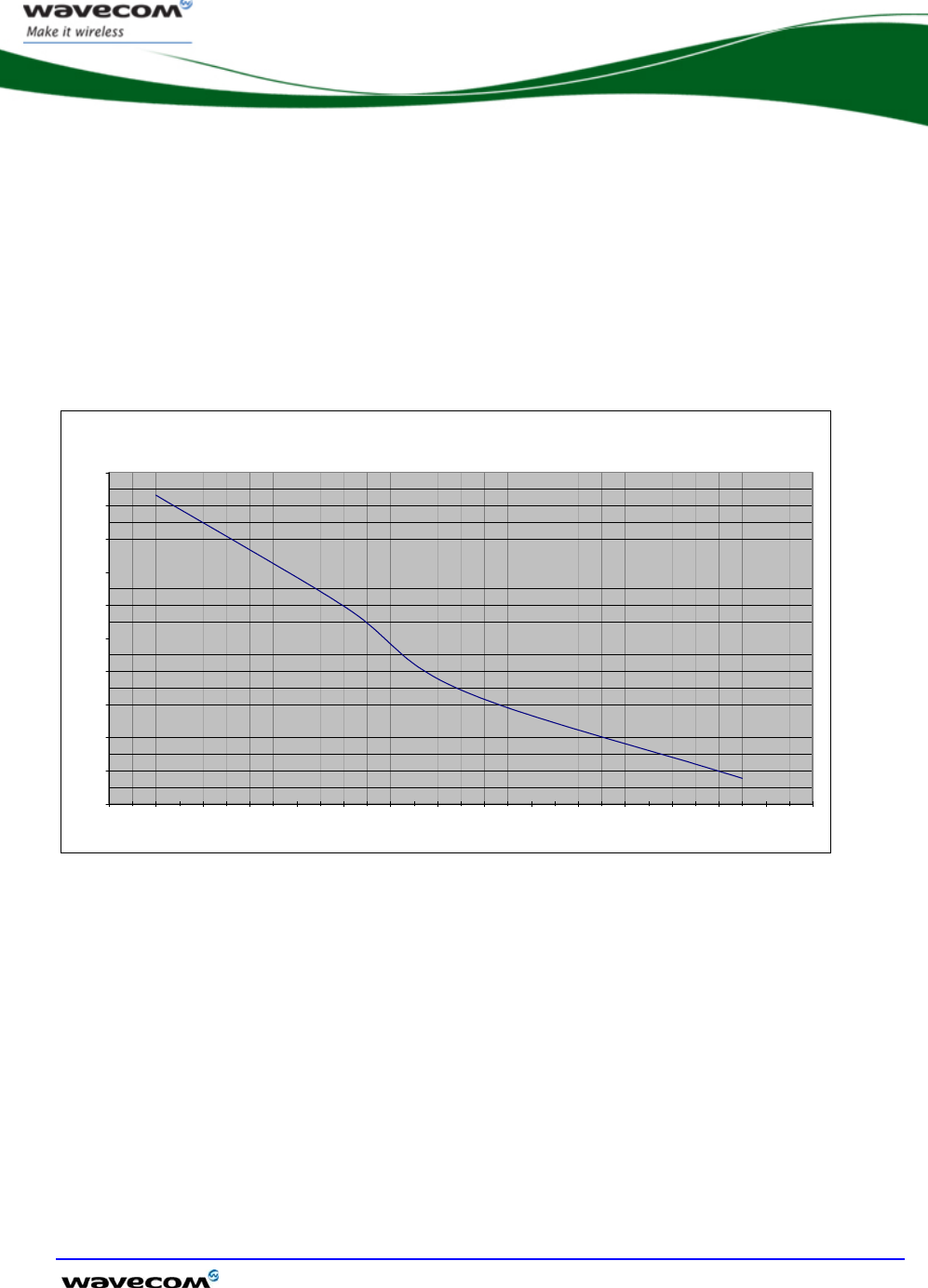
Wireless CPU Quik Q2687
Interfaces
©Confidential Page: 45 / 92
This document is the sole and exclusive property of Wavecom. Not to be distributed or divulged without
prior written agreement.
WA_ENG_Q2687_PTS_001-002 September 11, 2006
3.13 Temperature Sensor Interface
A temperature sensor is implanted in the Q2687 Wireless CPU. The software may
inform (via an ADC) the temperature in the Q2687 Wireless CPU. The following
waveform describes the characteristic of this function.
For more details, see the document [4].
The average step is 15mV / °C.
Characteristic of the Temperature Sensor
0
0,2
0,4
0,6
0,8
1
1,2
1,4
1,6
1,8
2
-50 -40 -30 -20 -10 0 10 20 30 40 50 60 70 80 90 100
Temperature (°C)
Voltage (V)
Figure 5: Characteristics of the Temperature Sensor

Wireless CPU Quik Q2687
Interfaces
©Confidential Page: 46 / 92
This document is the sole and exclusive property of Wavecom. Not to be distributed or divulged without
prior written agreement.
WA_ENG_Q2687_PTS_001-002 September 11, 2006
3.14 Analog Audio Onterface
Two different microphone inputs and two different speaker outputs are supported.
The Wireless CPU Quik Q2687 also includes an echo cancellation feature, which
allows hands-free functionality.

Wireless CPU Quik Q2687
Interfaces
©Confidential Page: 47 / 92
This document is the sole and exclusive property of Wavecom. Not to be distributed or divulged without
prior written agreement.
WA_ENG_Q2687_PTS_001-002 September 11, 2006
3.14.1 Microphone Inputs
The MIC2 inputs already include the biasing for an electret microphone, thus allowing
easy connection.
The MIC1 input requires external biasing, if an electret microphone is used.
3.14.1.1 Common microphone input characteristics
The connection may be either differential or single-ended but use of a differential
connection in order to reject common mode noise and TDMA noise is strongly
recommended. When using a single-ended connection, be sure to have a good
ground plane, good filtering and also shielding, in order to avoid any disturbance on
the audio path.
The gain of the MIC inputs is internally adjusted and may be tuned using an AT
command.
Both may be configured either as differential or single-ended.
3.14.1.2 Main Microphone Inputs (MIC2)
By default, the MIC2 inputs are differential inputs, but may also be configured as
single-ended. MIC2 inputs already include convenient biasing for an electret
microphone. The electret microphone may be directly connected to these inputs.
AC coupling is already embedded in the Wireless CPU.
Pin description of MIC2
Signal Pin
number
I/O I/O type Description
MIC2P 36 I Analog Microphone 2 positive input
MIC2N 34 I Analog Microphone 2 negative input
3.14.1.3 Auxiliary Microphone Inputs (MIC1)
By default, the MIC1 inputs are single-ended, but may also be configured as
differential. An external biasing is needed if an electret microphone is used.
AC coupling is already embedded in the Wireless CPU.
Pin description of MIC1
Signal Pin
number
I/O I/O type Description
MIC1P 40 I Analog Microphone 1 positive input
MIC1N 38 I Analog Microphone 1 negative input

Wireless CPU Quik Q2687
Interfaces
©Confidential Page: 48 / 92
This document is the sole and exclusive property of Wavecom. Not to be distributed or divulged without
prior written agreement.
WA_ENG_Q2687_PTS_001-002 September 11, 2006
3.14.1.4 Microphone Electrical Characteristics
The characteristics of both Wireless CPU Quik Q2687 microphone inputs are defined
in the following tables.
MIC2 Characteristics
Parameter Min. Typ Max. Unit
Voltage 2 2.1 2.2 V Internal
Biasing Output Current 1.5 mA
Internal AC coupling 100 nF
MIC2P (MIC2N left open) 1100 1340 1600 Ω
MIC2P (MIC2N = GND) 900 1140 1400 Ω
MIC2N (MIC2P left open) 1100 1340 1600 Ω
Impedance
single-ended
MIC2N (MIC2P = GND) 900 1140 1400 Ω
Differential Input Voltage* 346 mVRMS Input voltage
Absolute maximum ratings 0 6V ** V
MIC1 Characteristics
Parameter Min. Typ Max. Unit
Voltage N/A V Internal
Biasing Output Current N/A A
Internal AC coupling 100 nF
MIC1P (MIC1N left open) 70 100 162 kΩ
MIC1P (MIC1N = GND) 70 100 162 kΩ
MIC1N (MIC1P left open) 70 100 162 kΩ
Impedance
single-ended
MIC1N (MIC1P = GND) 70 100 162 kΩ
Differential Input Voltage * 346 mVRMS Input voltage
Absolute maximum ratings 0 6 V
* The input voltage depends on the input microphone gain set by AT command.
** Because MIC2P is internally biased, a coupling capacitor must be used to connect an audio signal
provided by an active generator. Only a passive microphone may be directly connected to the MI2P
and MIC2N inputs.

Wireless CPU Quik Q2687
Interfaces
©Confidential Page: 49 / 92
This document is the sole and exclusive property of Wavecom. Not to be distributed or divulged without
prior written agreement.
WA_ENG_Q2687_PTS_001-002 September 11, 2006
3.14.2 Common Speaker Output Characteristics
The connection is single-ended on SPK1 and either a differential or single-ended on
SPK2. Use of a differential connection to reject common mode noise and TDMA noise
is strongly recommended. Moreover, in single-ended mode, ½ of the power is lost.
When using a single-ended connection, be sure to have a good ground plane, a good
filtering and also shielding, in order to avoid any disturbance on the audio path.
3.14.2.1 Differential Connection
Impedance of the speaker amplifier output in differential mode is shown below:
Parameter Typ Unit
Z (SPK2P, SPK2N) 8 Ω
3.14.2.2 Single-ended Connection
Impedance of the speaker amplifier output in single-ended mode is shown below:
Electrical Characteristics
Parameter Typ Unit
Z (SPK1P, SPK1N) 16 or 32 Ω
Z (SPK2P, SPK2N) 4 Ω
3.14.3 Speaker Outputs
3.14.3.1 Speaker 2 Outputs
Pin description of Speaker 2 outputs
Signal Pin
number
I/O I/O type Description
SPK2P 39 O Analog Speaker 2 positive output
SPK2N 41 O Analog Speaker 2 negative output

Wireless CPU Quik Q2687
Interfaces
©Confidential Page: 50 / 92
This document is the sole and exclusive property of Wavecom. Not to be distributed or divulged without
prior written agreement.
WA_ENG_Q2687_PTS_001-002 September 11, 2006
3.14.3.2 Speaker 1 Outputs
Pin description of Speaker 1 outputs
Signal Pin
number
I/O I/O type Description
SPK1P 35 O Analog Speaker 1 positive output
SPK1N 37 O Analog Speaker 1 negative output
3.14.3.3 Speaker Output Power
The maximum power output of the two speakers is not the same due to different
configurations between Speaker1, which is only single-ended, and speaker2, which
may be differential. Speaker2 thus provides more power.
The maximum specifications given below are available with the maximum power
output configuration values set by AT command.
Speaker1 single-ended SPK1P output characteristics
Parameter Min. Typ Max. Unit
Output
Biasing
Voltage 1.30 V
Output
Voltage
0 2.75 VPP
Output
Power
Single-ended with 32-ohm
load
27 mW
Output
Current
Maximum tolerated 85 mA
Only SPK1P may be used.

Wireless CPU Quik Q2687
Interfaces
©Confidential Page: 51 / 92
This document is the sole and exclusive property of Wavecom. Not to be distributed or divulged without
prior written agreement.
WA_ENG_Q2687_PTS_001-002 September 11, 2006
Speaker2 differential output characteristics
Parameter Min. Typ Max. Unit
Output
Biasing
Voltage SPK2P and SPK2N 1.30 V
Voltage on SPK2P 0 0.9 VPP
Voltage on SPK2N 0 0.9 VPP
Output
Voltage
Diff voltage
(SPK2P – SPK2N)
0 1.8 VPP
Output
Power
Differential with 8-ohm load
48 mW
Output
Current
Maximum tolerated 110 mA
If a single-ended solution is used with the speaker2 output, only one of the two
SPK2s must be selected. The result is maximum output power divided by 2.
3.15 Buzzer Output
This output is controlled by a pulse width modulation controller and may be used
only as buzzer.
BUZZ-OUT is an open drain output. A buzzer may be directly connected between this
output and VBATT. The maximum current is 100 mA (PEAK).
Pin description of PWM/Buzzer output
Signal Pin
number
I/O I/O type Reset state Description
BUZZ-OUT 15 O Open
drain
Z Buzzer output
See Section 3.3, "Electrical information for digital I/O" for Open drain, 2V8 and 1V8 voltage characteristics
and Reset state definition.
Electrical Characteristics
Parameter Condition Minimum Maximum Unit
VOL on Iol = 100mA 0.4
V
IPEAK VBATT = VBATTmax 100 mA
Frequency 1 50000
Hz
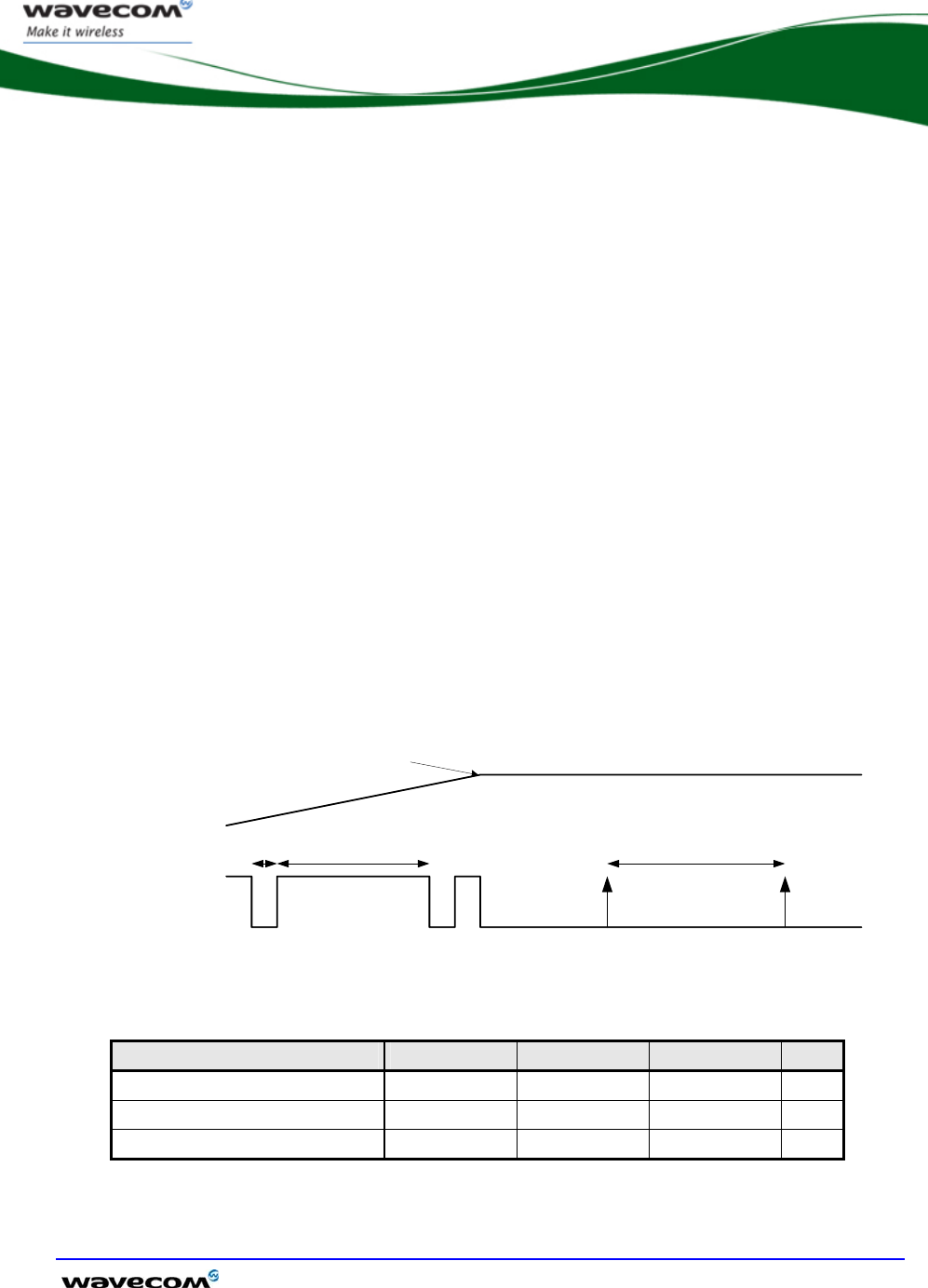
Wireless CPU Quik Q2687
Interfaces
©Confidential Page: 52 / 92
This document is the sole and exclusive property of Wavecom. Not to be distributed or divulged without
prior written agreement.
WA_ENG_Q2687_PTS_001-002 September 11, 2006
3.16 Battery Charging Interface
The Wireless CPU Quik Q2687 supports one battery charging circuit, two algorithms
and one hardware charging mode (pre-charging) for 3 battery technologies:
¾ Ni-Cd (Nickel-Cadmium) with algorithm 0
¾ Ni-Mh (Nickel-Metal Hydride) with algorithm 0
¾ Li-Ion (Lithium-Ion) with algorithm 1
The two algorithms control a switch, which connects the CHG-IN signal to the
VBATT signal. The algorithm controls the frequency and the connected time of the
switch. During the charging procedure, battery charging level is controlled and when
the Li-Ion algorithm is used, battery temperature is monitored via the BAT-TEMP ADC
input.
One more charging procedure is available in the Q2687 Wireless CPU. This is called
"Pre-charging" mode, but is a special charging mode as it is activated only when the
Wireless CPU is OFF. Control is thus performed by the hardware. The purpose of this
charging mode is to avoid battery damage by preventing the battery from being
discharged to below the minimum battery level.
3.16.1 Ni-Cd / Ni-Mh Charging Algorithm
To charge the battery, the algorithm measures battery level when the switch is open
(T2) and charges the battery by closing the switch (T3). When the battery is charged
(battery voltage reaches BattLevelMax) the switch is open for time T3.
BattLevelMax
T1T2 T3
Battery Level
Switch State
opened
closed
Figure 6 : Ni-Cd / Ni-Mh charging waveform
Electrical Characteristics of Ni-Cd / Ni-Mh battery timing charge
Parameter Min Typ Max Unit
T1 1 s
T2 0.1 s
T3 5 s
Note: T1,T2,T3, and BattLevelMax may be configured by AT command.
The battery level is monitored by the software (but not the temperature)
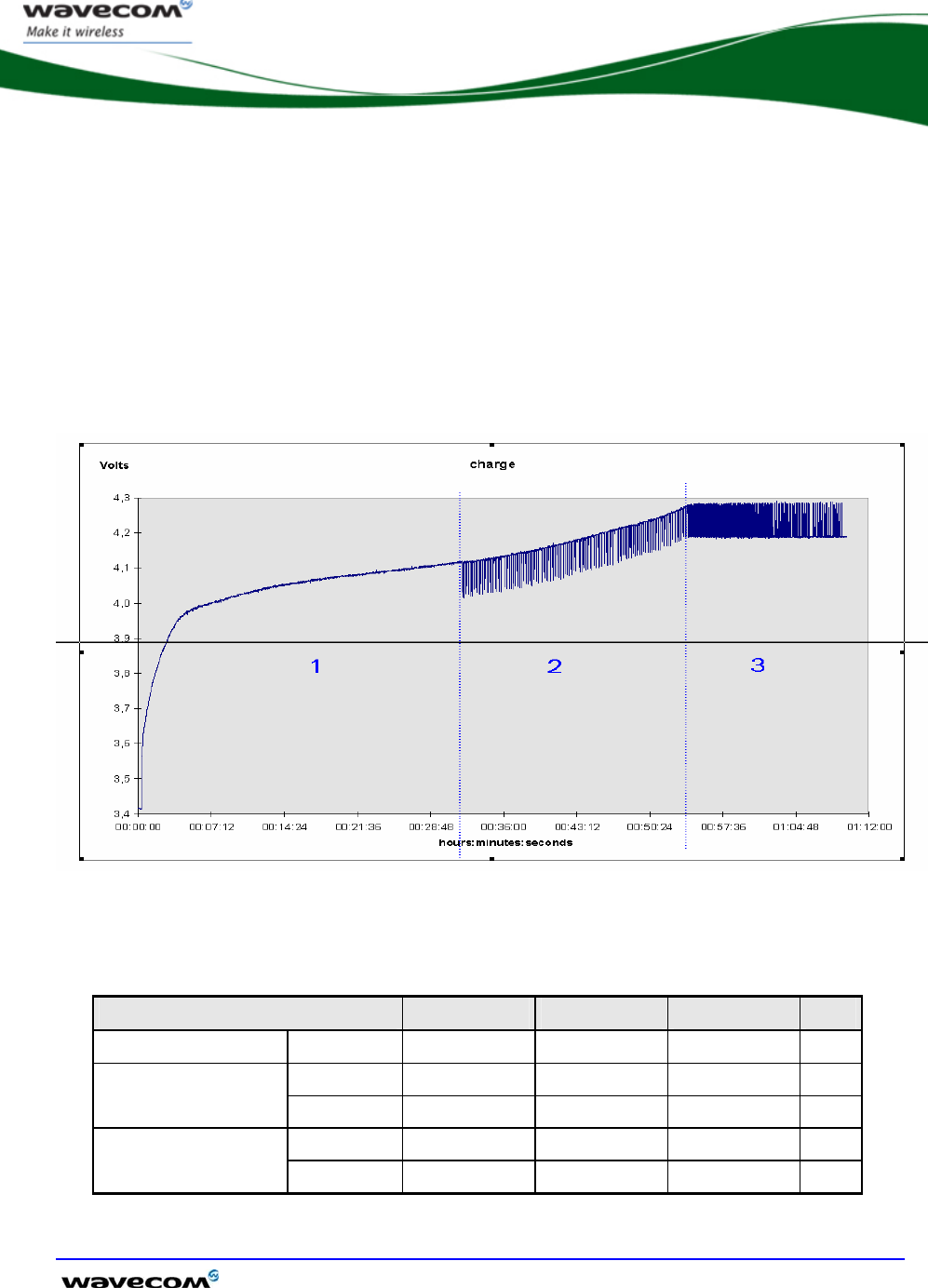
Wireless CPU Quik Q2687
Interfaces
©Confidential Page: 53 / 92
This document is the sole and exclusive property of Wavecom. Not to be distributed or divulged without
prior written agreement.
WA_ENG_Q2687_PTS_001-002 September 11, 2006
3.16.2 Li-Ion Charging Algorithm
The Li-Ion algorithm provides battery temperature monitoring, which is highly
recommended to prevent battery damage during the charging phase.
The Li-Ion charger algorithm may be configured into three phases:
1. Constant charge
2. Start of pulse charge
3. End of pulse charge
The three phases can be seen in the following waveform diagram for full-charging:
Figure 7: Li-Ion full-charging waveform
Electrical Characteristics of Li-Ion battery timing charge
Parameter Min Typ Max Unit
Step 1 switching Closed Always s
Open 0.1 s Step 2 switching
Closed 1 s
Open 0.1 10 s Step 3 switching
Closed 1 s

Wireless CPU Quik Q2687
Interfaces
©Confidential Page: 54 / 92
This document is the sole and exclusive property of Wavecom. Not to be distributed or divulged without
prior written agreement.
WA_ENG_Q2687_PTS_001-002 September 11, 2006
3.16.3 Controlled Pre-charging Hardware
The pre-charging mode which is hardware controlled (but not the software
controlled) is also available. This mode is only activated when the Wireless CPU is
OFF and when VBATT is in the voltage range of 2.8V < VBATT < 3.2V. The charger
power supply must be connected to CHG-IN (pin 6,8). In pre-charging mode, the
battery is charged with a direct current of 50mA. The FLASH-LED blinks, when this
mode is activated.
This mode is not a real charging mode as it is not possible to obtain a full charge with
it, but it is useful to save the battery life by preventing the battery from being
discharged to below the low limit voltage value.
3.16.4 Temperature Monitoring
Temperature monitoring is only available for the Li-Ion battery with algorithm 1. The
BAT-TEMP (pin 20) ADC input must be used to sample the temperature analog signal
provided by an NTC temperature sensor. The minimum and maximum temperature
range may be set by AT command.
Pin description of battery charging interface
Signal Pin number I/O I/O type Description
CHG-IN 6,8 I Analog Current source input
BAT-TEMP 20 I Analog A/D converter

Wireless CPU Quik Q2687
Interfaces
©Confidential Page: 55 / 92
This document is the sole and exclusive property of Wavecom. Not to be distributed or divulged without
prior written agreement.
WA_ENG_Q2687_PTS_001-002 September 11, 2006
Electrical characteristics of battery charging interface
Parameter Minimum Typ Maximum Unit
Charging operating temperature 0 50 °C
Resolution 10 bits
Sampling rate 216 S/s
Input Impedance ( R ) 1M Ω
BAT-TEMP (pin 20 )
Input signal range 0 2 V
Voltage (for I=Imax) 4.6* V
Voltage (for I=0) 6* V
CHG-IN (pin 6, 8 )
Current Imax 800 mA
* To be configured as specified by the battery manufacturer
3.17 ON / ~OFF Signal
This input is used to switch the Wireless CPU Quik Q2687 ON or OFF.
A high-level signal must be provided on the ON/~OFF pin to switch ON the Wireless
CPU. The voltage of this signal must be maintained for a minimum of 3000ms. This
signal may be left at high level until it is switched off.
To switch OFF the Wireless CPU, the ON/OFF pin must be released. The Wireless
CPU may be switched off via the Operating System.
3.17.1 Operating Sequences
3.17.1.1 Power ON
Once the Wireless CPU is supplied, the application must set the ON/OFF signal to
high to start the Wireless CPU power ON sequence. The ON/OFF signal must be held
for 3000ms minimum. After this period, an internal mechanism keeps it on hold.
During the power ON sequence, an internal reset is automatically performed by the
Wireless CPU for 40ms (typical). During this phase, any external reset should be
avoided. Once initialization is complete (timing is SIM- and network-dependent), the
AT interface answers "OK" to the application. For further details, please check the AT
Commands Interface Guide.
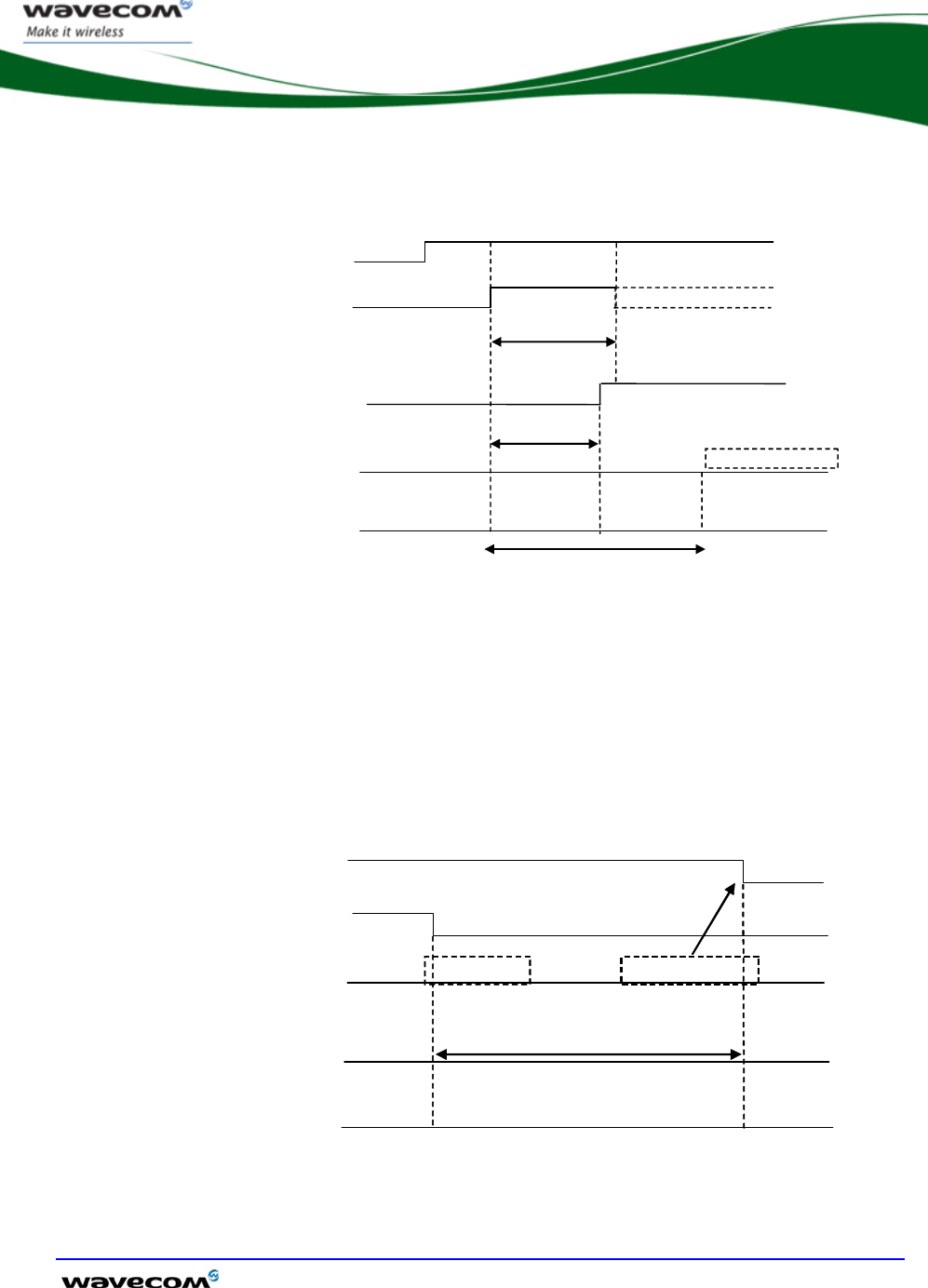
Wireless CPU Quik Q2687
Interfaces
©Confidential Page: 56 / 92
This document is the sole and exclusive property of Wavecom. Not to be distributed or divulged without
prior written agreement.
WA_ENG_Q2687_PTS_001-002 September 11, 2006
POWER SUPPLY
ON/OFF
STATE OF THE Wireless
CPU
Wireless CPU OFF
IBB+RF < 22µA
AT answers « OK »
Wireless CPU
READY
Ton/off-hold
(3000ms min)
SIM and Network dependent
RESET mode
IBB+RF=20 to 40mA
INTERNAL RS
T
Trst
(40ms typ)
Wireless CPU
ON
IBB+RF<120mA
(no loc. update)
IBB+RF = overall current consumption (Base Band + RF part)
Figure 8 : Power-ON sequence (no PIN code activated)
3.17.1.2 Power OFF
To power OFF the Wireless CPU correctly, the application must set the ON/OFF signal
to low and then send the AT+CPOF command to de-register from the network and
switch OFF the Wireless CPU. Once the "OK" response is issued by the Wireless CPU,
the power supply may be switched off.
POWER SUPPL
Y
ON/OFF
AT COMMAND
STATE OF THE Wireless
CPU
A
T+CPOF
Wireless
CPU
READY
Wireless
CPU OFF
IBB+RF<22µA
Network dependent
OK res
p
onse
IBB+RF = overall current consumption (Base Band + RF part)
Figure 9 : Power-OFF sequence

Wireless CPU Quik Q2687
Interfaces
©Confidential Page: 57 / 92
This document is the sole and exclusive property of Wavecom. Not to be distributed or divulged without
prior written agreement.
WA_ENG_Q2687_PTS_001-002 September 11, 2006
Pin description
Signal Pin number I/O I/O type Description
ON/∼OFF 19 I CMOS Wireless CPU Power
ON
Electrical characteristics of the signal
Parameter I/O type Minimum Maximum Unit
VIL CMOS VBATT x 0.2 V
VIH CMOS VBATT x 0.8 VBATT V
3.18 BOOT Signal
A specific BOOT control pin is available to download the Wireless CPU Quik Q2687
(only if the standard Xmodem download, controlled with AT command, is not
possible).
A specific PC software program, provided by Wavecom, is needed to perform this
specific download.
The BOOT pin must be connected to VCC_1V8 for this specific download.
Operating mode description
BOOT Operating mode Comment
Leave open Normal use No download
Leave open Download XMODEM AT command for Download
AT+WDWL
1 Download specific Need Wavecom PC software
For more information, see AT Commands Interface Guide for OS6.61 [4].
This BOOT pin must be left open for normal use or to download Xmodem.
However, in order to render the development and maintenance phases easier, it is
highly recommended to set a test point, either a jumper or a switch on the VCC_1V8
(pin 5) power supply.
Pin description
Signal Pin number I/O I/O type Description
BOOT 16 I 1V8 Download mode selection
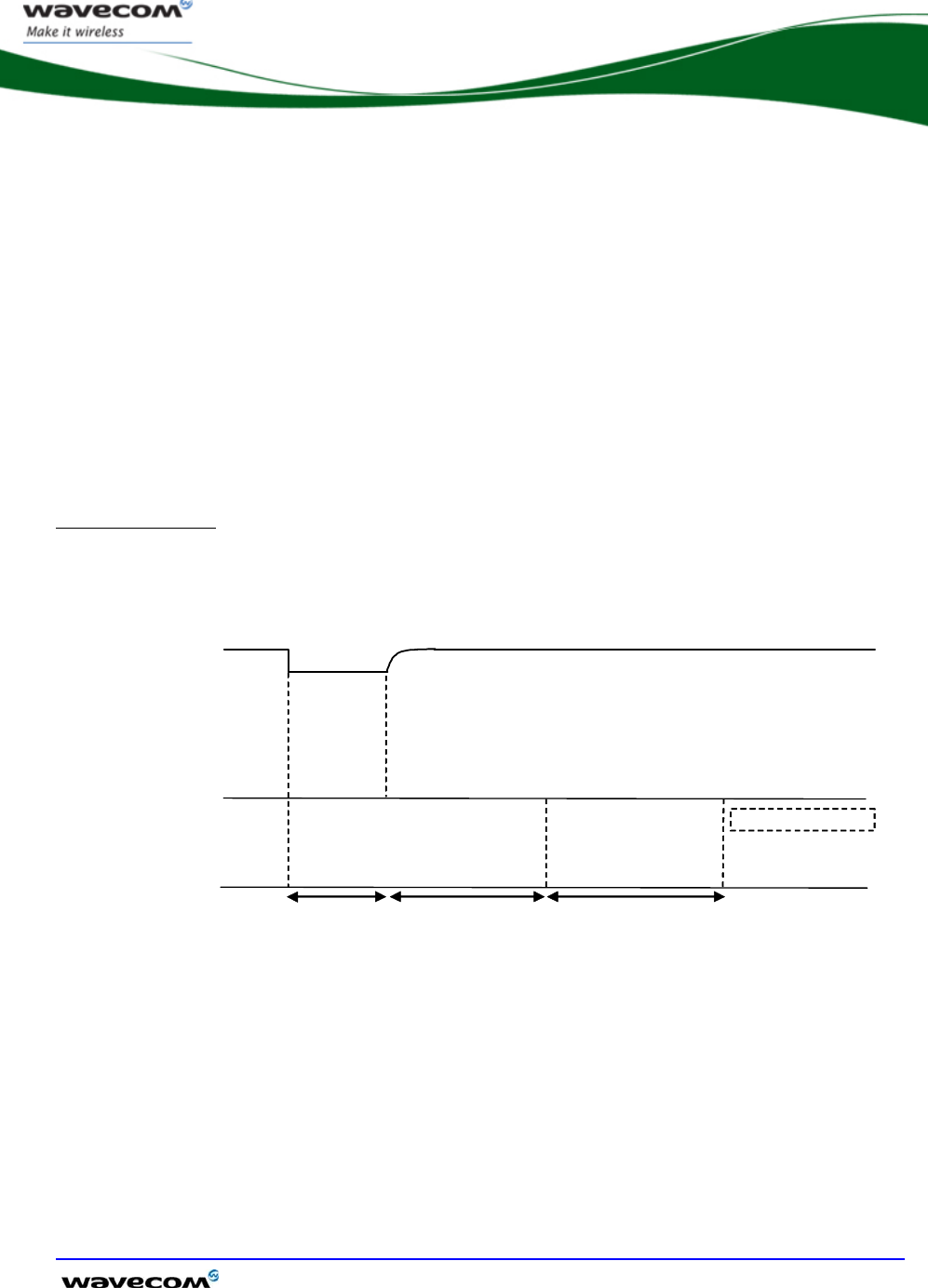
Wireless CPU Quik Q2687
Interfaces
©Confidential Page: 58 / 92
This document is the sole and exclusive property of Wavecom. Not to be distributed or divulged without
prior written agreement.
WA_ENG_Q2687_PTS_001-002 September 11, 2006
3.19 Reset Signal (~RESET)
This signal is used to force a reset procedure by providing low level for at least 200µs.
This signal must be considered as an emergency reset only. A reset procedure is
already driven by the internal hardware during the power-up sequence.
This signal may also be used to provide a reset to an external device (at power up
only). If no external reset is necessary, this input may be left open. If used
(emergency reset), it must be driven either by an open collector or an open drain.
The Wireless CPU remains in reset mode as long as the ~RESET signal is held low.
Caution
This signal should only be used for "emergency" resets.
An Operating System reset is preferred to a hardware reset.
Reset sequence:
To activate the "emergency" reset sequence, the ~RESET signal has to be set to low
for 200µs minimum. Once the reset is completed, the AT interface answers "OK" to
the application.
RESET mode
IBB+RF=20 to
40mA
~RESET
STATE OF THE
Wireless CPU
Wireless
CPU
READY
Rt = Min1:200µs
or Typ2 = 40ms
AT answers “OK”
Wireless CPU
READY
SIM and network
dependent
Wireless CPU
ON
IBB+RF<120mA
without loc update
Ct = Typ:34ms
Figure 10: Reset sequence waveform
At power-up, the ~RESET time (Rt) is carried out after switching ON the Wireless
CPU. It is generated by the internal voltage supervisor.
The ~RESET time is provided by the internal RC component. In order to keep the
same time, avoid connecting another R or C component on the ~RESET signal. Only a
switch or an open drain gate is recommended.
Ct is the cancellation time required for Wireless CPU initialization. Ct is automatically
carried out by after hardware reset.

Wireless CPU Quik Q2687
Interfaces
©Confidential Page: 59 / 92
This document is the sole and exclusive property of Wavecom. Not to be distributed or divulged without
prior written agreement.
WA_ENG_Q2687_PTS_001-002 September 11, 2006
Electrical characteristics of the signal
Parameter Minimum Typ Maximum Unit
Input Impedance ( R )* 330K Ω
Input Impedance ( C ) 10n F
~RESET time (Rt) 1 200 µs
~RESET time (Rt) 2 at power
up only
20 40 100
ms
Cancellation time (Ct) 34
ms
VH 0.57 V
VIL 0 0.57
V
VIH 1.33 V
* Internal pull-up
* VH: Hysterisis Voltage
1 This reset time is the minimum to be carried out on the ~RESET signal when the power supply is
already stable.
2 This reset time is internally carried out by the Wireless CPU power supply supervisor only when
the Wireless CPU power supplies are powered ON.
Pin description
Signal Pin
number
I/O I/O type Description
~RESET 18 I/O Open Drain
1V8 Wireless CPU
Reset
3.20 External Interrupt
The Wireless CPU Quik Q2687 provides two external interrupt inputs. These interrupt
inputs may be activated on:
• High to low edge
• Low to high edge
• Low to high and high to low edge
• Low level
• High level
When used, the interrupt inputs must not be left open.
If not used, they must be configured as GPIOs.

Wireless CPU Quik Q2687
Interfaces
©Confidential Page: 60 / 92
This document is the sole and exclusive property of Wavecom. Not to be distributed or divulged without
prior written agreement.
WA_ENG_Q2687_PTS_001-002 September 11, 2006
Pin description
Signal Pin
number
I/O I/O type Reset
state
Description Multiplexed
with
INT1 49 I 2V8 Z External Interrupt GPIO25
INT0 50 I 1V8 Z External Interrupt GPIO3
See Section 3.3, "Electrical information for digital I/O" for Open drain, 2V8 and 1V8 voltage characteristics
and Reset state definition.
Electrical characteristics of the signals
Parameter Minimum Maximum Unit
VIL 0.84
V
INT1
VIH 1.96 V
VIL 0.54
V
INT0 VIH 1.33 V
3.21 VCC_2V8 and VCC_1V8 Output
These outputs may only be used to connect pull-up resistor. VCC_2V8 and VCC_1V8
must be used as a reference supply. These voltages supplies are available when the
Wireless CPU is ON.
Pin description
Signal Pin number I/O I/O type Description
VCC_2V8 10 O Supply Digital supply
VCC_1V8 5 O Supply Digital supply
Electrical characteristics of the signals
Parameter Minimum Typ Maximum Unit
Output voltage 2.74 2.8 2.86 V
VCC_2V8
Output Current 15 mA
Output voltage 1.76 1.8 1.94 V
VCC_1V8 Output Current 15 mA
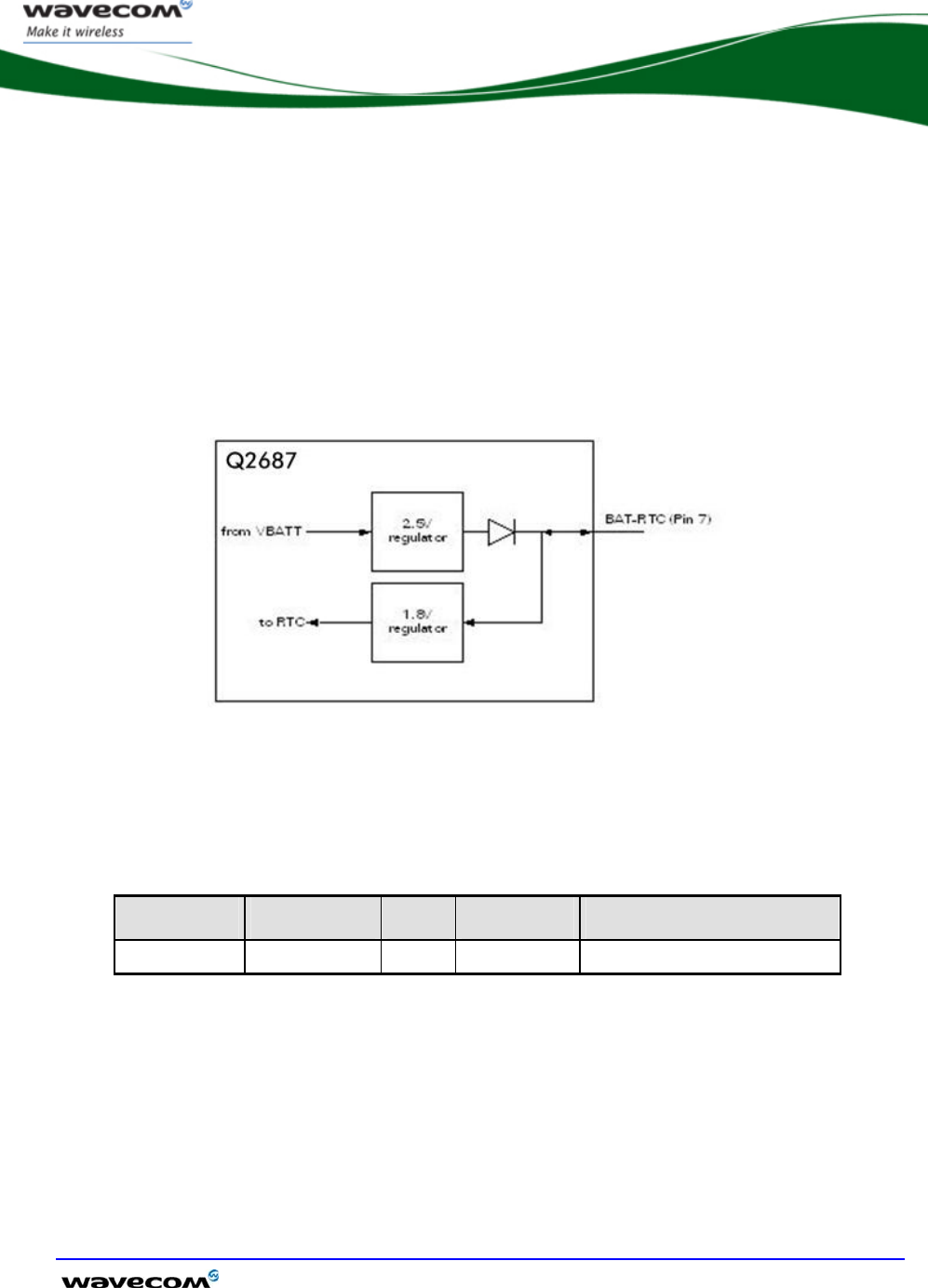
Wireless CPU Quik Q2687
Interfaces
©Confidential Page: 61 / 92
This document is the sole and exclusive property of Wavecom. Not to be distributed or divulged without
prior written agreement.
WA_ENG_Q2687_PTS_001-002 September 11, 2006
3.22 BAT-RTC (Back-up Battery)
The Wireless CPU Quik Q2687 provides an input/output to connect a Real Time Clock
(RTC) power supply.
3.22.1 Interface Description
This pin is used as a back-up power supply for the internal Real Time Clock (RTC).
The RTC is supported by the Wireless CPU when VBATT is available, but a back-up
power supply is needed to save date and time when VBATT is switched off (VBATT =
0V).
Figure 11: Real Time Clock power supply
If the RTC is not used, this pin may be left open.
If VBATT is available, the back-up battery may be charged by the internal 2.5V power
supply regulator.
Pin description
Signal Pin number I/O I/O type Description
BAT-RTC 7 I/O Supply RTC Back-up supply

Wireless CPU Quik Q2687
Interfaces
©Confidential Page: 62 / 92
This document is the sole and exclusive property of Wavecom. Not to be distributed or divulged without
prior written agreement.
WA_ENG_Q2687_PTS_001-002 September 11, 2006
Electrical characteristics of the signal
Parameter Minimum Typ Maximum Unit
Input voltage 1.85 2.5 V
Input current
consumption*
3.0 3.3 3.6 µA
Output voltage 2.40 2.45 2.50 V
Output current 2 mA
*Provided by an RTC back-up battery when Wireless CPU power supply is OFF (VBATT = 0V).
3.23 FLASH-LED Signal
FLASH-LED is an open drain output. An LED and a resistor may be directly connected
between this output and VBATT.
When the Q2687 Wireless CPU is OFF, if 2.8V < VBATT < 3.2V and a charger is
connected on CHG-IN inputs, this output flashes (100 ms ON, 900 ms OFF) to
indicate the pre-charging phase of the battery.
When the Q2687 Wireless CPU is ON, this output is used to indicate network status.

Wireless CPU Quik Q2687
Interfaces
©Confidential Page: 63 / 92
This document is the sole and exclusive property of Wavecom. Not to be distributed or divulged without
prior written agreement.
WA_ENG_Q2687_PTS_001-002 September 11, 2006
FLASH-LED status
Q2687
state
VBATT status FLASH-LED status Wireless CPU Quik Q2687
status
VBATT<2.8V or
VBATT> 3.2V
OFF Wireless CPU is OFF Wireless
CPU OFF
2.8V < VBATT
< 3.2V
Pre-charge flash
LED ON for 100 ms,
OFF for 900 ms
Wireless CPU is OFF,
Pre-charging mode
(charger must be connected on
CHG-IN to activate this mode)
Permanent Wireless CPU switched ON,
not registered on the network
Slow flash
LED ON for 200 ms,
OFF for 2 s
Wireless CPU switched ON,
registered on the network
Quick flash
LED ON for 200 ms,
OFF for 600 ms
Wireless CPU switched ON,
registered on the network,
communication in progress
Wireless
CPU ON
VBATT > 3.2V
Very quick flash
LED ON for 100ms,
OFF for 200ms
Wireless CPU switched ON,
software downloaded is either
corrupted or non-compatible
("BAD SOFTWARE")
Pin description
Signal Pin
number
I/O I/O type Reset state Description
FLASH-
LED
17 O Open Drain
Output
1 and
Undefined
LED driving
See Section 3.3, "Electrical information for digital I/O" for Open drain, 2V8 and 1V8 voltage characteristics
and Reset state definition.
Undefined
2s
Wireless CPU
Status
~RESET
pin 18
FLASH-LED
pin 17
1
led OFF
Figure 12: FLASH-LED state during RESET and Initialization time

Wireless CPU Quik Q2687
Interfaces
©Confidential Page: 64 / 92
This document is the sole and exclusive property of Wavecom. Not to be distributed or divulged without
prior written agreement.
WA_ENG_Q2687_PTS_001-002 September 11, 2006
FLASH-LED state is high during the RESET time and undefined during the software
initialization time. During software initialization time, for 2 seconds max after RESET
cancellation, the FLASH-LED signal is toggling and does not provide Wireless CPU
status. After the 2s period, the FLASH-LED provides the true status of the Wireless
CPU.
Electrical characteristics of the signal
Parameter Condition Minimum Typ Maximum Unit
VOL 0.4 V
IOUT 8 mA
3.24 Digital Audio Interface (PCM)
Digital audio interface (PCM) mode allows connectivity with audio standard
peripherals. It may be used, for example, to connect an external audio codec.
The programmability of this mode allows to address a large range of audio
peripherals.
PCM features:
• IOM-2 compatible device on physical level
• Master mode only with 6 slots by frame, user only on slot 0
• Bit rate single clock mode at 768KHz only
• 16 bits data word MSB first only
• Linear Law only (no compression law)
• Long Frame Synchronization only
• Push-pull configuration on PCM-OUT and PCM-IN
The digital audio interface configuration cannot differ from the above specified
features.
3.24.1 Description
The PCM interface consists of 4 wires:
• PCM-SYNC (output): The frame synchronization signal delivers an 8KHz
frequency pulse that synchronizes the frame data in and the frame data out.
• PCM-CLK (output): The frame bit clock signal controls data transfer with the
audio peripheral.
• PCM-OUT (output): The frame "data out" relies on the selected configuration
mode.
• PCM-IN (input): The frame "data in" relies on the selected configuration mode.
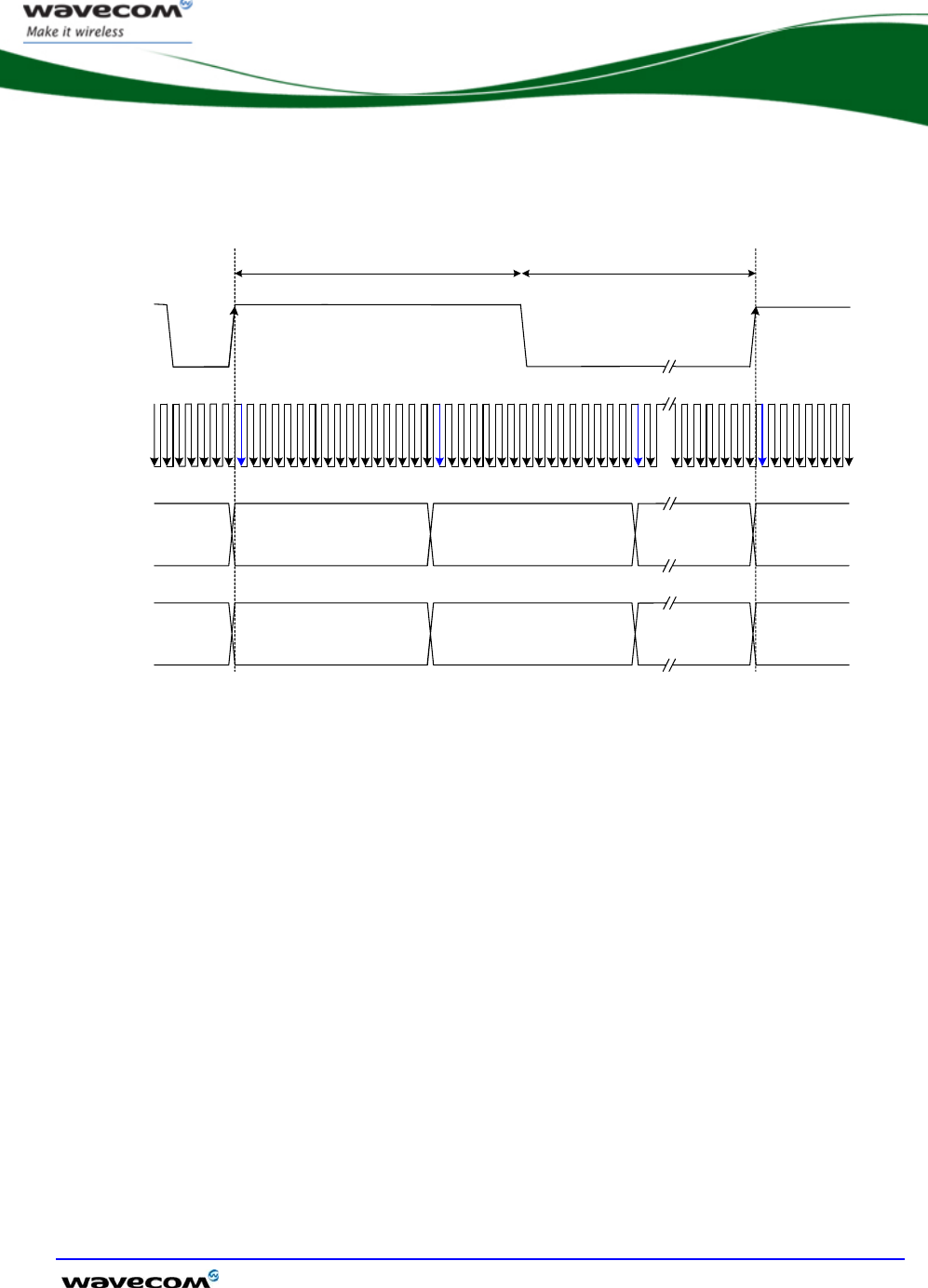
Wireless CPU Quik Q2687
Interfaces
©Confidential Page: 65 / 92
This document is the sole and exclusive property of Wavecom. Not to be distributed or divulged without
prior written agreement.
WA_ENG_Q2687_PTS_001-002 September 11, 2006
SLOT 0 SLOT 1 SLOT 5 SLOT 0
SLOT 0 SLOT 1 SLOT 5 SLOT 0
SLOT 5
SLOT 5
PCM-SYNC
PCM-CLK
PCM-IN
PCM-OUT
Tsync_high Tsync_low
End of frame
Begining of
frame
Figure 13: PCM frame waveform
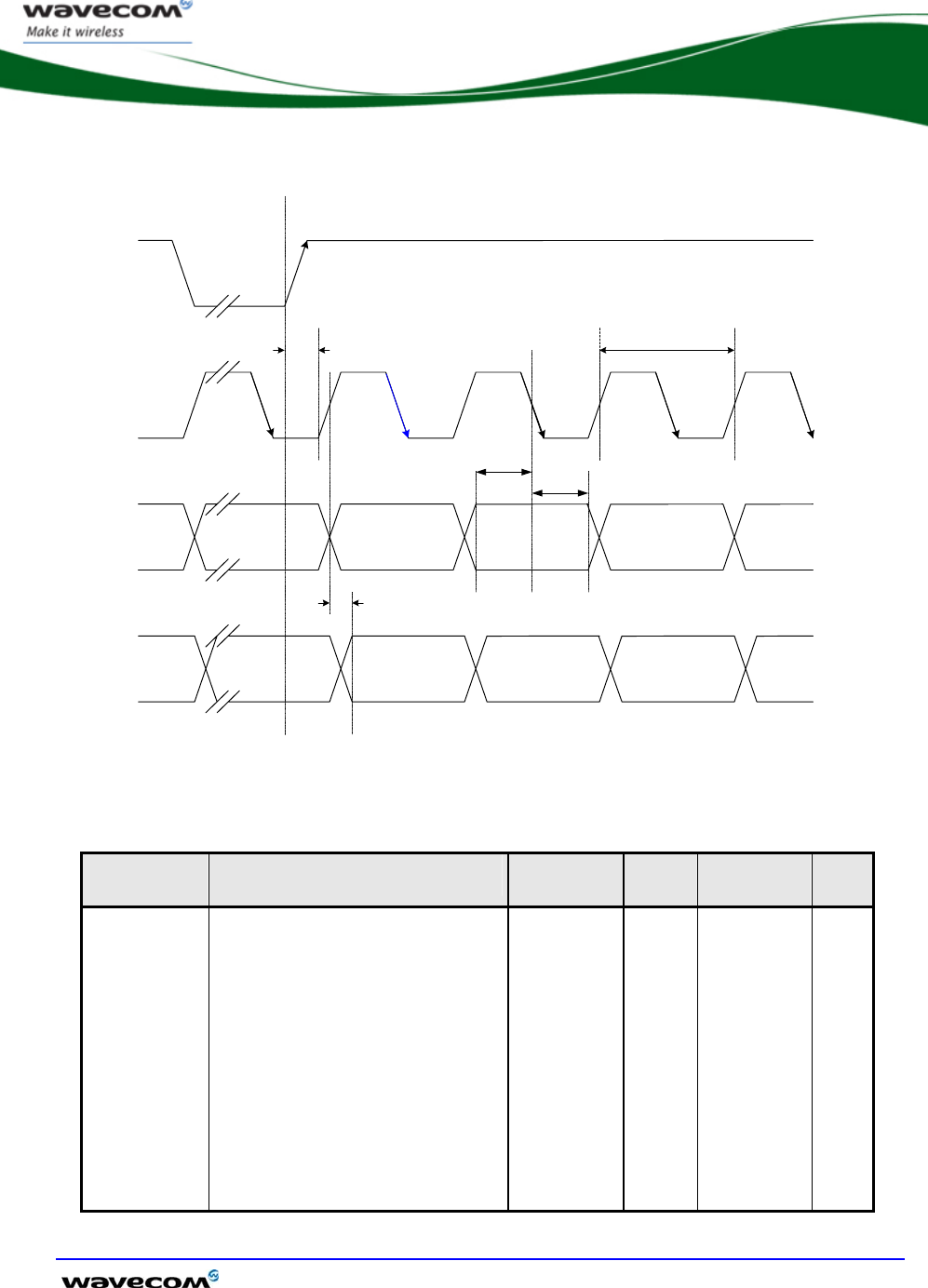
Wireless CPU Quik Q2687
Interfaces
©Confidential Page: 66 / 92
This document is the sole and exclusive property of Wavecom. Not to be distributed or divulged without
prior written agreement.
WA_ENG_Q2687_PTS_001-002 September 11, 2006
TOUTdelay
TSYNC-CLK
TCLK-cycle
TIN-hold
TIN-setup
PCM-SYNC
PCM-CLK
PCM-IN
PCM-OUT
SLOT 0 bit 15 SLOT 0 bit 14 SLOT 0 bit 13SLOT 5 bit 0
SLOT 0 bit 15 SLOT 0 bit 14 SLOT 0 bit 13SLOT 5 bit 0
Figure 14: PCM sampling waveform
AC characteristics
Signal Description Minimum Typ Maximum Unit
Tsync_low +
Tsync_high
PCM-SYNC period 125 µs
Tsync_low PCM-SYNC low time 93 µs
Tsync_high PCM-SYNC high time 32 µs
TSYNC-CLK PCM-SYNC to PCM-CLK time -154 Ns
TCLK-cycle PCM-CLK period 1302 Ns
TIN-setup PCM-IN setup time 50 Ns
TIN-hold PCM-IN hold time 50 Ns
TOUT-delay PCM-OUT delay time 20 Ns

Wireless CPU Quik Q2687
Interfaces
©Confidential Page: 67 / 92
This document is the sole and exclusive property of Wavecom. Not to be distributed or divulged without
prior written agreement.
WA_ENG_Q2687_PTS_001-002 September 11, 2006
Pin description of the PCM interface
Signal Pin
number
I/O I/O type Reset state Description
PCM-SYNC 77 O 1V8 Pull-down Frame synchronization
8Khz
PCM-CLK 79 O 1V8 Pull-down Data clock
PCM-OUT 80 O 1V8 Pull-up Data output
PCM-IN 78 I 1V8 Pull-up Data input
See Section 3.3, "Electrical information for digital I/O" for Open drain, 2V8 and 1V8 voltage characteristics
and Reset state definition.
3.25 USB 2.0 Interface
A 4-wire USB slave interface is available that complies with USB 2.0 protocol
signaling. But it is not compliant with the electrical interface, due to the 5V of VPAD-
USB.
The USB interface signals are VPAD-USB, USB-DP, USB-DM, and GND.
USB interface features:
• 12Mbit/s full-speed transfer rate
• 3.3V typ compatible
• USB Softconnect feature
• Download feature is not supported by USB
• CDC 1.1 – ACM compliant
Note:
A 5V to 3.3V typ voltage regulator is needed between the external interface power
inline (+5V) and the Wireless CPU line (VPAD-USB).
Pin description of the USB interface
Signal Pin
number
I/O I/O type Description
VPAD-USB 52 I VPAD_USB USB Power Supply
USB-DP 54 I/O VPAD_USB Differential data interface positive
USB-DM 56 I/O VPAD_USB Differential data interface negative

Wireless CPU Quik Q2687
Interfaces
©Confidential Page: 68 / 92
This document is the sole and exclusive property of Wavecom. Not to be distributed or divulged without
prior written agreement.
WA_ENG_Q2687_PTS_001-002 September 11, 2006
Electrical characteristics of the signals
Parameter Min Typ Max Unit
VPAD-USB, USB-DP, USB-DM 3 3.3 3.6 V
3.26 RF Interface
The impedance is 50 Ohms nominal and the DC impedance is 0 Ohm.
3.26.1 RF Connections
U.FL Connector
A wide variety of cables fitted with U.FL connectors is offered by different
suppliers.
Soldered solution
The soldered solution will preferably be based on an RG178 coaxial cable.
IMP connector
This connector is dedicated to board-to-board applications and must be soldered
on the customer board. The supplier is Radiall (reference: R107 064 900).
Notes:
• The Wireless CPU Quik Q2687 does not support an antenna switch for a car kit
but this function may be implemented externally and may be driven using a
GPIO.
• The antenna cable and connector should be selected in order to minimize
losses in the frequency bands used for GSM 850/900MHz and 1800/1900MHz.
• 0.5dB may be considered as the maximum value of loss between the Wireless
CPU and an external connector.
• For mounting, assembling and handling of the IMP connector, contact the
supplier, Radiall, directly. Wavecom may not provide customer support for use
of this connector.
3.26.2 RF Performance
RF performance is compliant with the ETSI GSM 05.05 recommendation.
The main Receiver parameters are:
• GSM850 Reference Sensitivity = -104 dBm Static & TUHigh
• E-GSM900 Reference Sensitivity = -104 dBm Static & TUHigh
• DCS1800 Reference Sensitivity = -102 dBm Static & TUHigh
• PCS1900 Reference Sensitivity = -102 dBm Static & TUHigh
• Selectivity @ 200 kHz: > +9 dBc

Wireless CPU Quik Q2687
Interfaces
©Confidential Page: 69 / 92
This document is the sole and exclusive property of Wavecom. Not to be distributed or divulged without
prior written agreement.
WA_ENG_Q2687_PTS_001-002 September 11, 2006
• Selectivity @ 400 kHz: > +41 dBc
• Linear dynamic range: 63 dB
• Co-channel rejection: >= 9 dBc
Transmitter parameters:
• Maximum output power (EGSM & GSM850): 33 dBm +/- 2 dB at ambient
temperature
• Maximum output power (GSM1800 & PCS1900): 30 dBm +/- 2 dB at ambient
temperature
• Minimum output power (EGSM & GSM850): 5 dBm +/- 5 dB at ambient
temperature
• Minimum output power (GSM1800 & PCS1900): 0 dBm +/- 5 dB at ambient
temperature
3.26.3 Antenna Specifications
The antenna must meet the following requirements as specified in the table below:
• The optimum operating frequency depends on the application. Either a dual-
band or a quad-band antenna may operate in these frequency bands and must
have the following characteristics:
Q2687
Characteristic E-GSM 900 DCS 1800 GSM 850 PCS 1900
TX Frequency 880 to
915 MHz
1710 to
1785 MHz
824 to
849 MHz
1850 to
1910 MHz
RX Frequency 925 to
960 MHz
1805
to 1880 MHz
869 to
894 MHz
1930 to
1990 MHz
Impedance 50 Ohms
Rx max 1.5:1
VSWR Tx max 1.5:1
Typical
radiated gain 0dBi in one direction at least

Wireless CPU Quik Q2687
Interfaces
©Confidential Page: 70 / 92
This document is the sole and exclusive property of Wavecom. Not to be distributed or divulged without
prior written agreement.
WA_ENG_Q2687_PTS_001-002 September 11, 2006
Caution: Q2687 and Q2686 are compatible, nevertheless, if intends to use Q2686 be
careful on these specific differences
Q2686 Q2687
Pin # Signal
Name
Multiplexed
with
Signal
Name
Multiplexed
with
42 Reserved - A1 Not mux
51 GPIO1 Not mux GPIO1 ~CS2/A25
53 GPIO2 Not mux GPIO2 A24
82 Reserved - AUX-DAC Not mux

Wireless CPU Quik Q2687
Technical Specifications
©Confidential Page: 71 / 92
This document is the sole and exclusive property of Wavecom. Not to be distributed or divulged without
prior written agreement.
WA_ENG_Q2687_PTS_001-002 September 11, 2006
4 Technical Specifications
4.1 General Purpose Connector Pin-out Description
Signal Name
Pin
Number Nominal Mux
I/O
type Voltage I/O* Reset
State Description Dealing with
unused pins
1 VBATT VBATT I Power Supply
2 VBATT VBATT I Power Supply
3 VBATT VBATT I Power Supply
4 VBATT VBATT I Power Supply
5 VCC_1V8 VCC_1V8 O 1.8V Supply Output NC
6 CHG-IN CHG-IN I Charger input NC
7 BAT-RTC BAT-RTC I/O RTC Battery
connection NC
8 CHG-IN CHG-IN I Charger input NC
9 SIM-VCC 1V8 or 3V O SIM Power Supply
10 VCC_2V8 VCC_2V8 O 2.8V Supply Output NC
11 SIM-IO
1V8 or 3V I/O
Pull-up
(about
10K)
SIM Data
12 SIMPRES GPIO18 C1 VCC_1V8 I Z SIM Detection NC
13 ~SIM-RST 1V8 or 3V O 0 SIM reset Output
14 SIM-CLK 1V8 or 3V O 0 SIM Clock
15 BUZZ-
OUT A1 Open Drain O Z Buzzer Output NC
16 BOOT
VCC_1V8 I Not Used
Add a test point / a
jumper/ a switch to
VCC_1V8 (Pin 5) in
case Download
Specific mode is
used (See product
specification for
details)
17 FLASH-
LED
A1
Open Drain O
1 and
Undefine
d
Flash Led Output NC
18 ~RESET C4 VCC_1V8 I/O RESET Input NC or add a test
point
19 ON/~OFF VBATT I ON / ~OFF Control

Wireless CPU Quik Q2687
Technical Specifications
©Confidential Page: 72 / 92
This document is the sole and exclusive property of Wavecom. Not to be distributed or divulged without
prior written agreement.
WA_ENG_Q2687_PTS_001-002 September 11, 2006
Signal Name
Pin
Number Nominal Mux
I/O
type Voltage I/O* Reset
State Description Dealing with
unused pins
20 BAT-
TEMP A3 Analog I Analog temperature Pull to GND
21 AUX-ADC A2 Analog I Analog to Digital
Input Pull to GND
22 ~SPI1-CS GPIO31 C1 VCC_2V8 O Z SPI1 Chip Select NC
23 SPI1-CLK GPIO32 C1 VCC_2V8 O Z SPI1 Clock NC
24 SPI1-I GPIO30 C1 VCC_2V8 I Z SPI1 Data Input NC
25 SPI1-IO GPIO29 C1 VCC_2V8 I/O Z SPI1 Data Input /
Output NC
26 SPI2-CLK GPIO32 C1 VCC_2V8 O Z SPI2 Clock NC
27 SPI2-IO GPIO33 C1 VCC_2V8 I/O Z SPI2 Data Input /
Output NC
28 ~SPI2-CS GPIO35 C1 VCC_2V8 O Z SPI2 Chip Select NC
29 SPI2-I GPIO34 C1 VCC_2V8 I Z SPI2 Data Input NC
30 CT104-
RXD2 GPIO15 C1 VCC_1V8 O Z Auxiliary RS232
Receive
Add a test point for
firmware upgrade
31 CT103-
TXD2 GPIO14
C1
VCC_1V8 I Z Auxiliary RS232
Transmit
(TXD2) Pull-up to
VCC_1V8 with
100kΩ and add a
test point for
firmware update
32 ~CT106-
CTS2 GPIO16
C1
VCC_1V8 O Z Auxiliary RS232
Clear To Send
(CTS2) Add a test
point for firmware
update
33 ~CT105-
RTS2 GPIO17
C1
VCC_1V8 I Z Auxiliary RS232
Request To Send
(RTS2) Pull-up to
VCC_1V8 with
100kΩ and add a
test point for
firmware update
34 MIC2N A4 Analog I Micro 2 Input
Negative NC
35 SPK1P A5 Analog O Speaker 1 Output
Positive NC
36 MIC2P A4 Analog I Micro 2 Input
Positive NC
37 SPK1N A5 Analog O Speaker 1 Output
Negative NC
38 MIC1N A4 Analog I Micro 1 Input
Negative NC
39 SPK2P A5 Analog O Speaker 2 Output
Positive NC
40 MIC1P A4 Analog I Micro 1 Input
Positive NC
41 SPK2N A5 Analog O Speaker 2 Output
Negative NC
42 A1 VCC_1V8 O Address bus 1 NC

Wireless CPU Quik Q2687
Technical Specifications
©Confidential Page: 73 / 92
This document is the sole and exclusive property of Wavecom. Not to be distributed or divulged without
prior written agreement.
WA_ENG_Q2687_PTS_001-002 September 11, 2006
Signal Name
Pin
Number Nominal Mux
I/O
type Voltage I/O* Reset
State Description Dealing with
unused pins
43 GPIO44 C1 VCC_2V8 I/O
Undefine
d NC
44 SCL GPIO26
A1 Open Drain O Z I²C Clock NC
45 GPIO19 C1 VCC_2V8 I/O Z NC
46 SDA GPIO27
A1 Open Drain I/O Z I²C Data NC
47 GPIO21 C1 VCC_2V8 I/O
Undefine
d NC
48 GPIO20 C1 VCC_2V8 I/O
Undefine
d NC
49 INT1 GPIO25
C1
VCC_2V8 I Z Interruption 1 Input
If INT1 is not used,
it should be
configured as GPIO
50 INT0 GPIO3
C1
VCC_1V8 I Z Interruption 0 Input
If INT0 is not used,
it should be
configured as GPIO
51 GPIO1 ** C1 VCC_1V8 I/O
Undefine
d NC
52 VPAD-
USB VPAD-USB I USB Power supply
input NC
53 GPIO2 ** C1 VCC_1V8 I/O
Undefine
d NC
54 USB-DP VPAD-USB I/O USB Data NC
55 GPIO23 ** C1 VCC_2V8 I/O Z NC
56 USB-DM VPAD-USB I/O USB Data NC
57 GPIO22 ** C1 VCC_2V8 I/O Z NC
58 GPIO24 C1 VCC_2V8 I/O Z NC
59 COL0 GPIO4 C8 VCC_1V8 I/O Pull-up Keypad column 0 NC
60 COL1 GPIO5 C8 VCC_1V8 I/O Pull-up Keypad column 1 NC
61 COL2 GPIO6 C8 VCC_1V8 I/O Pull-up Keypad column 2 NC
62 COL3 GPIO7 C8 VCC_1V8 I/O Pull-up Keypad column 3 NC
63 COL4 GPIO8 C8 VCC_1V8 I/O Pull-up Keypad column 4 NC
64 ROW4 GPIO13 C7 VCC_1V8 I/O 0 Keypad Row 4 NC
65 ROW3 GPIO12 C7 VCC_1V8 I/O 0 Keypad Row 3 NC
66 ROW2 GPIO11 C7 VCC_1V8 I/O 0 Keypad Row 2 NC
67 ROW1 GPIO10 C7 VCC_1V8 I/O 0 Keypad Row 1 NC
68 ROW0 GPIO9 C7 VCC_1V8 I/O 0 Keypad Row 0 NC
69 ~CT125-
RI GPIO42 C1 VCC_2V8 O
Undefine
d
Main RS232 Ring
Indicator NC

Wireless CPU Quik Q2687
Technical Specifications
©Confidential Page: 74 / 92
This document is the sole and exclusive property of Wavecom. Not to be distributed or divulged without
prior written agreement.
WA_ENG_Q2687_PTS_001-002 September 11, 2006
Signal Name
Pin
Number Nominal Mux
I/O
type Voltage I/O* Reset
State Description Dealing with
unused pins
70 ~CT109-
DCD1 GPIO43 C1 VCC_2V8 O
Undefine
d
Main RS232 Data
Carrier Detect NC
71 CT103-
TXD1 GPIO36
C1
VCC_2V8 I Z Main RS232
Transmit
(TXD1) Pull-up to
VCC_2V8 with
100kΩ and add a
test point for
firmware update
72 ~CT105-
RTS1 GPIO38
C1
VCC_2V8 I Z Main RS232
Request To Send
(RTS1) Pull-up to
VCC_2V8 with
100kΩ and add a
test point for
firmware update
73 CT104-
RXD1 GPIO37
C1
VCC_2V8 O 1 Main RS232
Receive
(RXD1) Add a test
point for firmware
update
74 ~CT107-
DSR1 GPIO40 C1 VCC_2V8 O Z Main RS232 Data
Set Ready NC
75 ~CT106-
CTS1 GPIO39
C1
VCC_2V8 O Z Main RS232 Clear
To Send
(CTS1) Add a test
point for firmware
update
76 ~CT108-
2-DTR1 GPIO41
C1
VCC_2V8 I Z Main RS232 Data
Terminal Ready
(DTR1) Pull-up to
VCC_2V8 with
100kΩ
77 PCM-
SYNC VCC_1V8 O Pull-
down
PCM Frame
Synchro NC
78 PCM-IN C5 VCC_1V8 I Pull-up PCM Data Input NC
79 PCM-CLK VCC_1V8 O Pull-
down PCM Clock NC
80 PCM-OUT VCC_1V8 O Pull-up PCM Data Output NC
81 /OE-R/W VCC_1V8 O Output Enable/
Read not write NC
82 AUX-DAC Analog O Digital to Analog
Output NC
83 /CS3 VCC_1V8 O Chip Select 3 NC
84 /WE-E VCC_1V8 O Write Enable NC
85 D0 VCC_1V8 I/O Data for Peripheral NC
86 D15 VCC_1V8 I/O Data for Peripheral NC
87 D1 VCC_1V8 I/O Data for Peripheral NC
88 D14 VCC_1V8 I/O Data for Peripheral NC
89 D2 VCC_1V8 I/O Data for Peripheral NC
90 D13 VCC_1V8 I/O Data for Peripheral NC
91 D3 VCC_1V8 I/O Data for Peripheral NC
92 D12 VCC_1V8 I/O Data for Peripheral NC

Wireless CPU Quik Q2687
Technical Specifications
©Confidential Page: 75 / 92
This document is the sole and exclusive property of Wavecom. Not to be distributed or divulged without
prior written agreement.
WA_ENG_Q2687_PTS_001-002 September 11, 2006
Signal Name
Pin
Number Nominal Mux
I/O
type Voltage I/O* Reset
State Description Dealing with
unused pins
93 D4 VCC_1V8 I/O Data for Peripheral NC
94 D11 VCC_1V8 I/O Data for Peripheral NC
95 D5 VCC_1V8 I/O Data for Peripheral NC
96 D10 VCC_1V8 I/O Data for Peripheral NC
97 D6 VCC_1V8 I/O Data for Peripheral NC
98 D9 VCC_1V8 I/O Data for Peripheral NC
99 D7 VCC_1V8 I/O Data for Peripheral NC
100 D8 VCC_1V8 I/O Data for Peripheral NC
* The I/O direction information is only for the nominal signal. When the signal is configured in GPIO, it
can always be an Input or an Output.
** For more information about the multiplexing of these signals, see "General purpose
input /output", Section 1.1
4.2 Environmental Specifications
Wavecom specifies the following temperature range for the Q2687 product.
The Q2687 Wireless CPU is compliant with the following operating class.
Conditions Temperature range
Operating / Class A -20 °C to +55°C
Operating / Storage / Class B -40 °C to +85°C
Function Status Classification:
Class A:
The Wireless CPU remains fully functional, meeting GSM performance criteria in
accordance with ETSI requirements, across the specified temperature range.
Class B:
The Wireless CPU remains fully functional, across the specified temperature range.
Some GSM parameters may occasionally deviate from the ETSI specified
requirements and this deviation does not affect the ability of the Wireless CPU to
connect to the cellular network and fully functional, as it does within the Class A
range.

Wireless CPU Quik Q2687
Technical Specifications
©Confidential Page: 76 / 92
This document is the sole and exclusive property of Wavecom. Not to be distributed or divulged without
prior written agreement.
WA_ENG_Q2687_PTS_001-002 September 11, 2006
Q2687 ENVIRONNEMENTAL CLASSES
TYPE OF TEST STANDARDS STORAGE TRANSPORTATION OPERATING (PORT USE)
Class 1.2 Class 2.3 Class 7.3
Cold IEC 68-2.1 -25° C 72 h -40° C 72 h -20° C (GSM900) 16 h
Ab test -10° C (GSM1800/1900) 16h
Dry heat IEC 68-2.2 +70° C 72 h +70° C 72 h +55° C 16 h
Bb test
Change of temperature IEC 68-2.14 -40° / +30° C 5 cycles -20° / +30° C (GSM900) 3 cycles
Na/Nb test t1 = 3 h -10° / +30° C (GSM1800/1900):
3 cycles t1 = 3 h
Damp heat IEC 68-2.30 +30° C 2 cycles +40° C 2 cycles +40° C 2 cycles
cyclic Db test 90% - 100% RH 90% - 100% RH 90% - 100% RH
variant 1 variant 1 variant 1
Damp heat IEC 68-2.56 +30° C 4 days +40° C 4 days +40° C 4 days
Cb test
Sinusoidal vibration IEC 68-2.6 5 - 62 Hz : 5 mm / s
Fc test 62 - 200Hz : 2 m / s2
3 x 5 sweep cycles
5 - 20 Hz : 0.96 m2 / s3 10 -12 Hz : 0.96 m2 / s3
Random vibration IEC 68-3.36 20 - 500Hz : - 3 dB / oct 12 - 150Hz : - 3 dB / oct
wide band Fdb test 3 x 10 min 3 x 30 min
Figure 15: Environmental classes

Wireless CPU Quik Q2687
Technical Specifications
©Confidential Page: 77 / 92
This document is the sole and exclusive property of Wavecom. Not to be distributed or divulged without
prior written agreement.
WA_ENG_Q2687_PTS_001-002 September 11, 2006
4.3 Mechanical specifications
4.3.1 Physical Characteristics
The Wireless CPU Quik Q2687 has a complete self-contained shield.
• Overall dimensions : 32.2x40x4 mm (except shielding pins)
• Weight : <10 g
4.3.2 Mechanical Drawings
The mechanical specifications of the Wireless CPU Quik Q2687 are shown on the
following page.
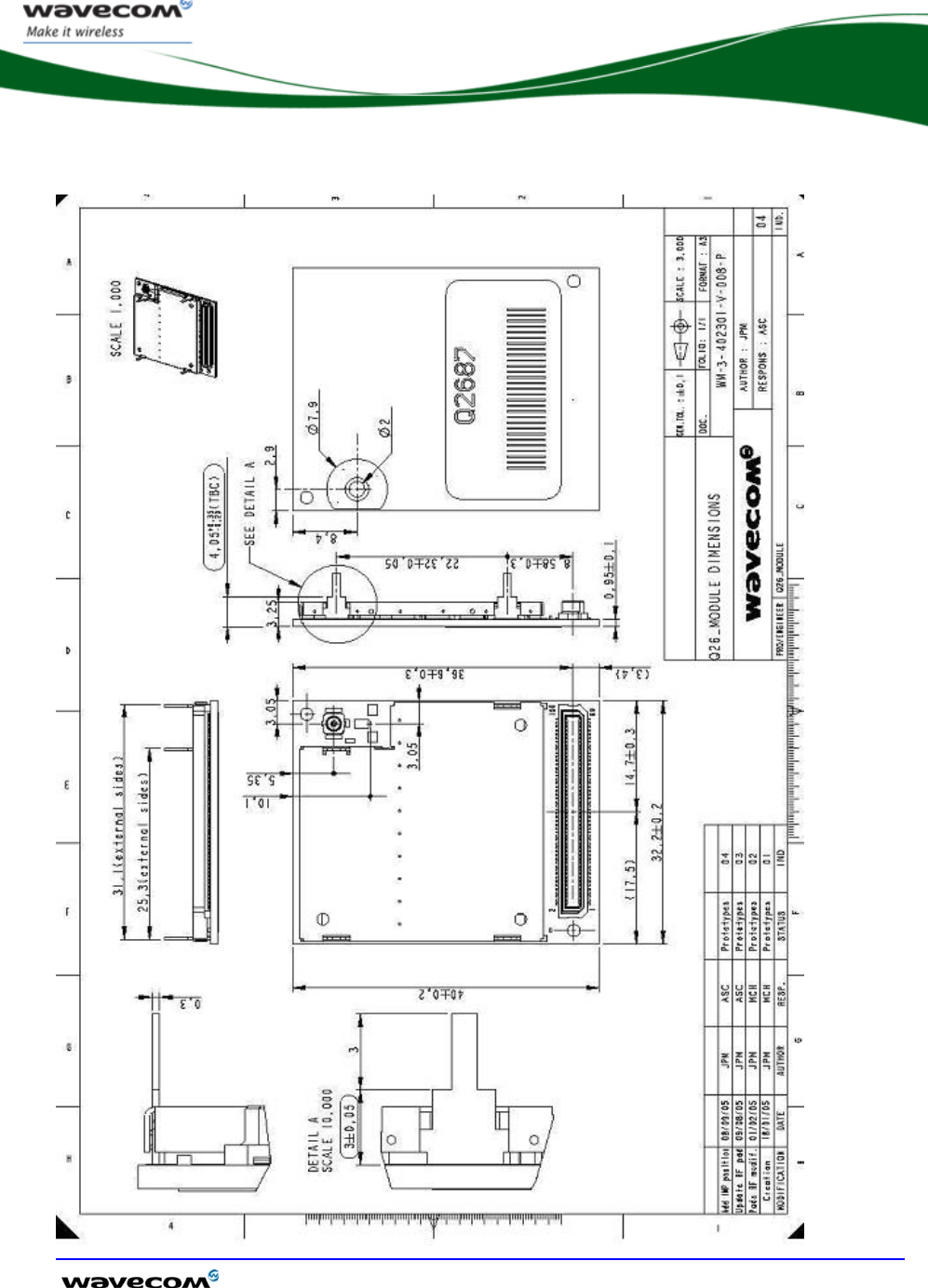
Wireless CPU Quik Q2687
Technical Specifications
©Confidential Page: 78 / 92
This document is the sole and exclusive property of Wavecom. Not to be distributed or divulged without
prior written agreement.
WA_ENG_Q2687_PTS_001-002 September 11, 2006

Wireless CPU Quik Q2687
Connector and Peripheral Device References
©Confidential Page: 79 / 92
This document is the sole and exclusive property of Wavecom. Not to be distributed or divulged without
prior written agreement.
WA_ENG_Q2687_PTS_001-002 September 11, 2006
5 Connector and Peripheral Device References
5.1 General Purpose Connector
The GPC is a 100-pin connector with 0.5mm pitch from the PANASONIC Group's P5K
series, with the following reference:
AXK69510002
The matting connector has the following reference:
AXK59510001
The stacking height is 3.0 mm.
Wavecom recommends that you use the AXK59510001 connector for your
application to benefit from Wavecom’s prices. For more information, contact
Wavecom, specifying the Wavecom connector reference: WM17077.
For further details see the GPC data sheets in the Appendix. More information is also
available from http://www.panasonic.com/host/industrl.html
5.2 SIM Card Reader
• ITT CANNON CCM03 series (see http://www.ittcannon.com )
• AMPHENOL C707 series (see http://www.amphenol.com )
• JAE (see http://www.jae.com )
• MOLEX 99228-0002 (connector) / MOLEX 91236-0002 (holder) (see
http://www.molex.com)
5.3 Microphone
Possible suppliers:
• HOSIDEN
• PANASONIC
• PEIKER

Wireless CPU Quik Q2687
Connector and Peripheral Device References
©Confidential Page: 80 / 92
This document is the sole and exclusive property of Wavecom. Not to be distributed or divulged without
prior written agreement.
WA_ENG_Q2687_PTS_001-002 September 11, 2006
5.4 Speaker
Possible suppliers:
• SANYO
• HOSIDEN
• PRIMO
• PHILIPS
5.5 Antenna Cable
A wide variety of cables fitted with UF-L connectors is offered by HIROSE:
UF-L pigtails, Ex: Ref = U.FL-2LP(V)-04-A-(100)
UF-L Ref = U.FL-R-SMT
UF-L cable assemblies,
Between series cable assemblies.
More information is also available from http://www.hirose-connectors.com/.
A coaxial cable may also be soldered on the RF pad. The following references have
been certified for mounting on the Q2687 Wireless CPU:
• RG178
• RG316
5.6 RF board-to-board Connector
The supplier for the IMP connector is Radiall (http://www.radiall.com), with the
following reference:
• R107 064 900.
5.7 GSM Antenna
GSM antennas and support for antenna adaptation may be obtained from
manufacturers such as:
• ALLGON (http://www.allgon.com )
• IRSCHMANN (http://www.hirschmann.com/ )

Wireless CPU Quik Q2687
Design Guidelines
©Confidential Page: 81 / 92
This document is the sole and exclusive property of Wavecom. Not to be distributed or divulged without
prior written agreement.
WA_ENG_Q2687_PTS_001-002 September 11, 2006
6 Design Guidelines
The purpose of the following paragraphs is to give design guidelines.
6.1 Hardware and RF
6.1.1 EMC Recommendations
The EMC tests must be performed on the application as soon as possible to detect
any potential problems.
When designing, special attention should be paid to:
• Possible spurious emission radiated by the application to the RF receiver in the
receiver band
• ESD protection is mandatory on all signals which have external accessibility
(typically human accessibility). See Q2687 Wireless CPU Customer Design
Guidelines WM_DEV_Q2687_PTS_007 [2] for ESD protection samples.
o Similarly, ESD protection is mandatory for the:
SIM (if accessible from outside)
Serial link
• EMC protection on audio input/output (filters against 900MHz emissions)
• Biasing of the microphone inputs
• Length of the SIM interface lines (preferably <10cm)
• Ground plane: Wavecom recommends a common ground plane for
analog/digital/RF grounds.
• A metallic case or plastic casing with conductive paint are recommended
Note:
The Wireless CPU does not include any protection against over-voltage.
6.1.2 Power Supply
The power supply is one of the key issues in the design of a GSM terminal.
A weak power supply design could, in particular, affect:
• EMC performance
• The emission spectrum
• The phase error and frequency error

Wireless CPU Quik Q2687
Design Guidelines
©Confidential Page: 82 / 92
This document is the sole and exclusive property of Wavecom. Not to be distributed or divulged without
prior written agreement.
WA_ENG_Q2687_PTS_001-002 September 11, 2006
Warning:
Careful attention should be paid to:
The quality of the power supply: low ripple, PFM or PSM systems should be avoided
(PWM converter preferred).
Capacity to deliver high current peaks in a short time (pulsed radio emission).
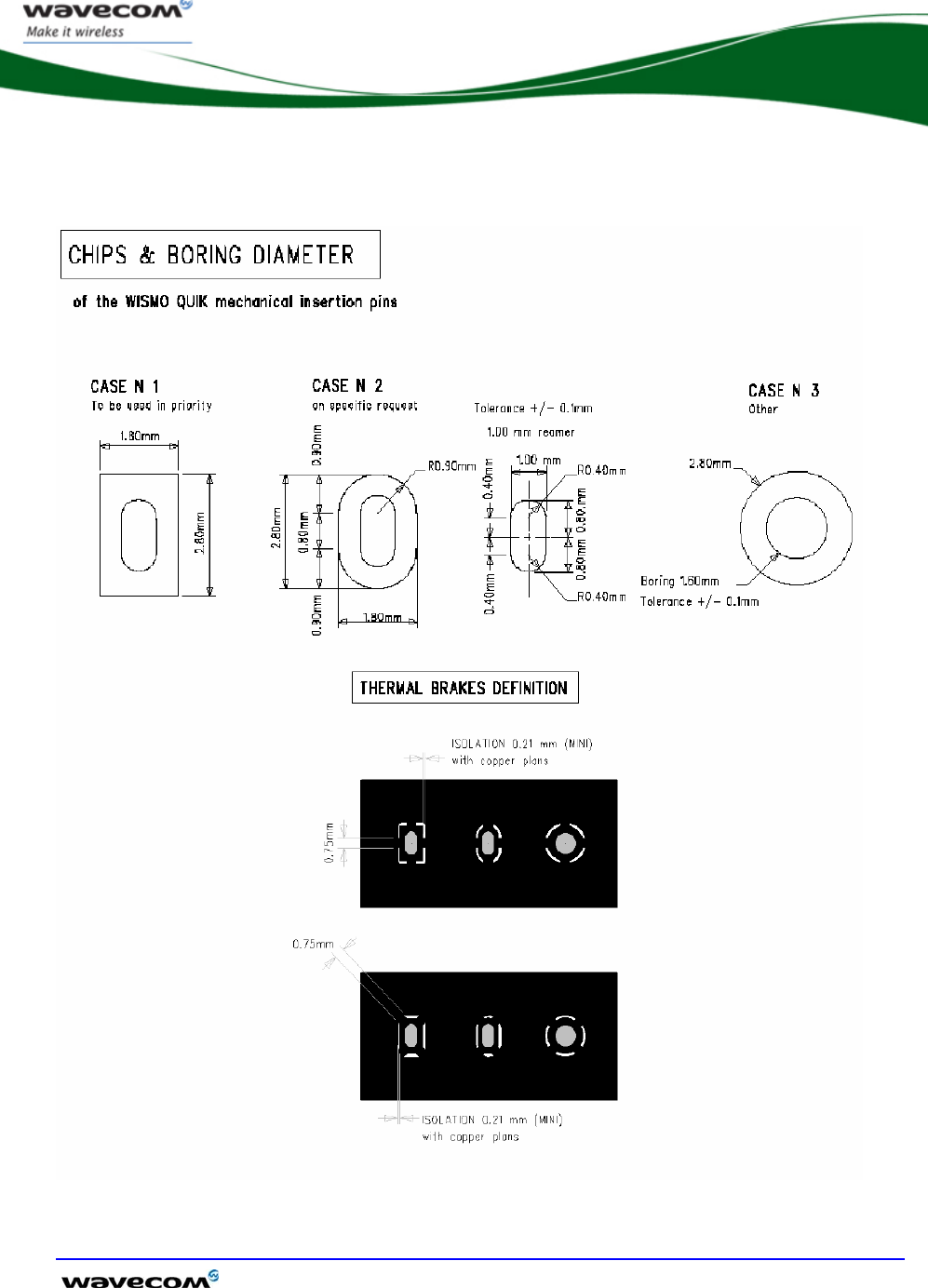
Wireless CPU Quik Q2687
Design Guidelines
©Confidential Page: 83 / 92
This document is the sole and exclusive property of Wavecom. Not to be distributed or divulged without
prior written agreement.
WA_ENG_Q2687_PTS_001-002 September 11, 2006
6.1.3 Layout Requirement
Figure 16: Layout requirement

Wireless CPU Quik Q2687
Design Guidelines
©Confidential Page: 84 / 92
This document is the sole and exclusive property of Wavecom. Not to be distributed or divulged without
prior written agreement.
WA_ENG_Q2687_PTS_001-002 September 11, 2006
6.1.4 Antenna
Warning:
Wavecom strongly recommends to work with an antenna manufacturer either to
develop an antenna adapted to the application or to adapt an existing solution to the
application.
Both the mechanical and electrical antenna adaptation are one of the key issues in
the design of GSM terminal.
6.2 Mechanical Integration
Attention should be paid to:
• Antenna cable integration (bending, length, position, etc)
• Leads of the Wireless CPU to be soldered to the Ground plane
6.3 Operating System Upgrade
The Wireless CPU Quik Q2687 Operating System is stored in flash memory and may
easily be upgraded.
IMPORTANT:
In order to follow regular changes in the GPRS standard and to offer a state-of-the-art
Operating System, Wavecom recommends that the application designed around a
WISMO (or WISMO based product) allow easy Operating System upgrades on the
Wireless CPU via the standard Xmodem protocol. Therefore, the application shall
either allow a direct access to the WISMO serial link through an external connector or
implement any mechanism allowing the WISMO Operating System to be downloaded
via Xmodem.
The Operating System file may be downloaded to the Wireless CPU using the
Xmodem protocol. The AT+WDWL command allows the download process to be
launched (see the description in the AT Command User Guide).
The serial signals required to proceed with Xmodem downloading are:
Rx, Tx, RTS, CTS and GND.
The Operating System file may also be downloaded to the Wireless CPU using the
DOTA (download over the air) feature. This feature is available with the Open AT®
interface. For more details, please, refer to the Open AT® documentation.

Wireless CPU Quik Q2687
Appendix
©Confidential Page: 85 / 92
This document is the sole and exclusive property of Wavecom. Not to be distributed or divulged without
prior written agreement.
WA_ENG_Q2687_PTS_001-002 September 11, 2006
7 Appendix
7.1 Standards and Recommendations
GSM ETSI, 3GPP, GCF and NAPRD03 recommendations for Phase II & FCC.
Specification Reference Title
3GPP TS 45.005 v5.5.0
(2002-08) Release 5
Technical Specification Group GSM/EDGE. Radio
Access Network; Radio transmission and reception
GSM 02.07 V8.0.0
(1999-07)
Digital cellular telecommunications system (Phase 2+);
Mobile Stations (MS) features (GSM 02.07
version 8.0.0 Release 1999)
GSM 02.60 V8.1.0
(1999-07)
Digital cellular telecommunications system (Phase 2+);
General Packet Radio Service (GPRS);
Service description, Stage 1 (GSM 02.60 version 8.1.0
Release 1999)
GSM 03.60 V7.9.0
(2002-09)
Technical Specification Group Services and System
Aspects;
Digital cellular telecommunications system (Phase 2+);
General Packet Radio Service (GPRS);
Service description; Stage 2 (Release 1998)
3GPP TS 43.064 V5.0.0
(2002-04)
Technical Specification Group GERAN; Digital cellular
telecommunications system (Phase 2+); General Packet
Radio Service (GPRS); Overall description of the GPRS
radio interface; Stage 2 (Release 5)
3GPP TS 03.22 V8.7.0
(2002-08)
Technical Specification Group GSM/EDGE. Radio
Access Network; Functions related to Mobile Station
(MS) in idle mode and group receive mode; (Release
1999)
3GPP TS 03.40 V7.5.0
(2001-12)
Technical Specification Group Terminals;
Technical realization of the Short Message Service
(SMS)
(Release 1998)
3GPP TS 03.41 V7.4.0
(2000-09)
Technical Specification Group Terminals; Technical
realization of Cell Broadcast Service (CBS)
(Release 1998)

Wireless CPU Quik Q2687
Appendix
©Confidential Page: 86 / 92
This document is the sole and exclusive property of Wavecom. Not to be distributed or divulged without
prior written agreement.
WA_ENG_Q2687_PTS_001-002 September 11, 2006
Specification Reference Title
ETSI EN 300 903 V8.1.1
(2000-11)
Digital cellular telecommunications system (Phase 2+);
Transmission planning aspects of the speech service in
the GSM
Public Land Mobile Network (PLMN) system
(GSM 03.50 version 8.1.1 Release 1999)
3GPP TS 04.06 V8.2.1
(2002-05)
Technical Specification Group GSM/EDGE Radio Access
Network; Mobile Station - Base Station System
(MS - BSS) interface; Data Link (DL) layer specification
(Release 1999)
3GPP TS 04.08 V7.18.0
(2002-09)
Technical Specification Group Core Network;
Digital cellular telecommunications system (Phase 2+);
Mobile radio interface layer 3 specification (Release
1998)
3GPP TS 04.10 V7.1.0
(2001-12)
Technical Specification Group Core Networks;
Mobile radio interface layer 3 Supplementary services
specification; General aspects (Release 1998)
3GPP TS 04.11 V7.1.0
(2000-09)
Technical Specification Group Core Network; Digital
cellular telecommunications system (Phase 2+);
Point-to-Point (PP) Short Message Service (SMS)
support on mobile radio interface
(Release 1998)
3GPP TS 45.005 v5.5.0
(2002-08)
Technical Specification Group GSM/EDGE. Radio
Access Network; Radio transmission and reception
(Release 5)
3GPP TS 45.008 V5.8.0
(2002-08)
Technical Specification Group GSM/EDGE
Radio Access Network; Radio subsystem link control
(Release 5)
3GPP TS 45.010 V5.1.0
(2002-08)
Technical Specification Group GSM/EDGE
Radio Access Network; Radio subsystem
synchronization (Release 5)
3GPP TS 46.010 V5.0.0
(2002-06)
Technical Specification Group Services and System
Aspects;
Full rate speech; Transcoding (Release 5)

Wireless CPU Quik Q2687
Appendix
©Confidential Page: 87 / 92
This document is the sole and exclusive property of Wavecom. Not to be distributed or divulged without
prior written agreement.
WA_ENG_Q2687_PTS_001-002 September 11, 2006
Specification Reference Title
3GPP TS 46.011 V5.0.0
(2002-06)
Technical Specification Group Services and System
Aspects;
Full rate speech; Substitution and muting of lost
frames for
Full rate speech channels (Release 5)
3GPP TS 46.012 V5.0.0
(2002-06)
Technical Specification Group Services and System
Aspects;
Full rate speech; Comfort noise aspect for full rate
speech traffic channels (Release 5)
3GPP TS 46.031 V5.0.0
(2002-06)
Technical Specification Group Services and System
Aspects;
Full rate speech; Discontinuous Transmission (DTX) for
full rate speech traffic channels (Release 5)
3GPP TS 46.032 V5.0.0
(2002-06)
Technical Specification Group Services and System
Aspects;
Full rate speech; Voice Activity Detector (VAD) for full
rate speech traffic channels (Release 5)
TS 100 913V8.0.0
(1999-08)
Digital cellular telecommunications system (Phase 2+);
General on Terminal Adaptation Functions (TAF) for
Mobile Stations (MS) (GSM 07.01 version 8.0.0
Release 1999)
GSM 09.07 V8.0.0
(1999-08)
Digital cellular telecommunications system (Phase 2+);
General requirements on interworking between the
Public Land Mobile Network (PLMN) and the Integrated
Services Digital Network (ISDN) or Public Switched
Telephone Network (PSTN) (GSM 09.07 version 8.0.0
Release 1999)
3GPP TS 51.010-1 v5.0.0
(2002-09)
Technical Specification Group GSM/EDGE ; Radio
Access Network ;Digital cellular telecommunications
system (Phase 2+);Mobile Station (MS) conformance
specification; Part 1: Conformance specification
(Release 5)
3GPP TS 51.011 V5.0.0
(2001-12)
Technical Specification Group Terminals; Specification
of the Subscriber Identity Module - Mobile Equipment
(SIM - ME) interface (Release 5)
ETS 300 641 (1998-03) Digital cellular telecommunications system (Phase 2);
Specification of the 3 Volt Subscriber Identity Module -
Mobile Equipment (SIM-ME) interface (GSM 11.12
version 4.3.1)

Wireless CPU Quik Q2687
Appendix
©Confidential Page: 88 / 92
This document is the sole and exclusive property of Wavecom. Not to be distributed or divulged without
prior written agreement.
WA_ENG_Q2687_PTS_001-002 September 11, 2006
Specification Reference Title
GCF-CC V3.7.1 (2002-08) Global Certification Forum – Certification criteria
NAPRD03 V2.6.0 (2002-06) North America Permanent Reference Document for
PTCRB tests
The Wireless CPU Quik Q2687 connected on a development kit board application is
certified to be in accordance with the following Rules and Regulations of the Federal
Communications Commission (FCC).
Power listed on the Gant is conducted for Part 22 and conducted for Part 24
This device contains GSM, GPRS/EGPRS Class 10 functions in the 900 and 1800MHz
Band, which are not operational in U.S. Territories.
This device is to be used only for mobile and fixed applications. The antenna(s) used
for this transmitter must be installed to provide a separation distance of at least 20cm
from all persons and must not be co-located or operating in conjunction with any
other antenna or transmitter.
Users and installers must be provided with antenna installation instructions and
transmitter operating conditions for satisfying RF exposure compliance.
Antennas used for this OEM module must not exceed 1.4 dBi gain for GSM 850 MHz
and 7 dBi for GSM 1900 MHz for fixed operating configurations. For mobile
operations the gain must not exceed 1.4 dBi for GSM 850 MHz and 3dBi for GSM
1900 MHz. This device is approved as a module to be installed in other devices.
Installed in portable devices, the RF exposure condition requires a separate
mandatory equipment authorization for the final device.
The license module will have a FCC ID label on the module itself. The FCC ID label
must be visible through a window or it must be visible when an access panel, door or
cover is easily removed.
If not, a second label must be placed on the outside of the device that contains the
following text:
Contains FCC ID: O9EQ2687
This device complies with Part 15 of the FCC Rules. Operation is subject to the
following two conditions:
o This device may not cause harmful interference.
o This device must accept any interference received, including interference
that may cause undesired operation.

Wireless CPU Quik Q2687
Appendix
©Confidential Page: 89 / 92
This document is the sole and exclusive property of Wavecom. Not to be distributed or divulged without
prior written agreement.
WA_ENG_Q2687_PTS_001-002 September 11, 2006
IMPORTANT:
Manufacturers of mobile or fixed devices incorporating Q2687 Wireless CPU are
advised to:
• clarify any regulatory questions,
• have their completed product tested,
• have product approved for FCC compliance, and
• include instructions according to above mentioned RF exposure statements in end
product user manual.
Please note that changes or modifications not stated clearly approved by the party
responsible for compliance could void the user’s authority to operate the equipment.
7.2 Safety Recommendations (for Information only)
IMPORTANT
FOR THE EFFICIENT AND SAFE OPERATION OF YOUR GSM APPLICATION
BASED ON WIRELESS CPU QUIK Q2687
PLEASE READ THIS INFORMATION CAREFULLY
7.2.1 RF Safety
7.2.1.1 General
Your GSM terminal1 is based on the GSM standard for cellular technology. The GSM
standard is spread all over the world. It covers Europe, Asia and some parts of
America and Africa. This is the most used telecommunication standard.
Your GSM terminal is actually a low power radio transmitter and receiver. It sends
out as well as receives radio frequency energy. When you use your GSM application,
the cellular system which handles your calls controls both the radio frequency and
the power level of your cellular modem.
7.2.1.2 Exposure to RF energy
There has been some public concern about possible health effects of using GSM
terminals. Although research on health effects from RF energy has focused on the
current RF technology for many years, scientists have begun research regarding
newer radio technologies, such as GSM. After existing research had been reviewed,
and after compliance to all applicable safety standards had been tested, it has been
concluded that the product was fitted for use.
If you are concerned about exposure to RF energy there are things you can do to
minimize exposure. Obviously, limiting the duration of your calls will reduce your
1 based on WISMO2D

Wireless CPU Quik Q2687
Appendix
©Confidential Page: 90 / 92
This document is the sole and exclusive property of Wavecom. Not to be distributed or divulged without
prior written agreement.
WA_ENG_Q2687_PTS_001-002 September 11, 2006
exposure to RF energy. In addition, you can reduce RF exposure by operating your
cellular terminal efficiently by following the guidelines below.
7.2.1.3 Efficient Terminal Operation
For your GSM terminal to operate at the lowest power level, consistent with
satisfactory call quality:
If your terminal has an extendable antenna, extend it fully. Some models allow you to
place a call with the antenna retracted. However, your GSM terminal operates more
efficiently with the antenna when it is fully extended.
Do not hold the antenna when the terminal is "IN USE". Holding the antenna affects
call quality and may cause the modem to operate at a higher power level than
needed.
7.2.1.4 Antenna Care and Replacement
Do not use the GSM terminal with a damaged antenna. If a damaged antenna comes
into contact with the skin, a minor burn may result. Replace the damaged antenna
immediately. You may repair antenna yourself by following the instruction manual
provided to you. If so, use only a manufacturer-approved antenna. Otherwise, have
your antenna repaired by a qualified technician.
Buy or replace the antenna only from the approved suppliers list. Using of
unauthorized antennas, modifications or attachments could damage the terminal and
may violate local RF emission regulations or invalidate type approval.
7.2.2 General Safety
7.2.2.1 Driving
Check the laws and the regulations regarding the use of cellular devices in the area
where you have to drive, as you always have to comply with them. When using your
GSM terminal while driving, please:
• give full attention to driving,
• pull-off the road and park before making or answering a call (if driving
conditions so require).
7.2.2.2 Electronic Devices
Most electronic equipments, for example in hospitals and motor vehicles are shielded
from RF energy. However, RF energy may affect some improperly shielded electronic
equipment.

Wireless CPU Quik Q2687
Appendix
©Confidential Page: 91 / 92
This document is the sole and exclusive property of Wavecom. Not to be distributed or divulged without
prior written agreement.
WA_ENG_Q2687_PTS_001-002 September 11, 2006
7.2.2.3 Vehicle Electronic Equipment
Check your vehicle manufacturer representative to determine if any on-board
electronic equipment is adequately shielded from RF energy.
7.2.2.4 Medical Electronic Equipment
Consult the manufacturer of any personal medical devices (such as pacemakers,
hearing aids, etc...) to determine if they are adequately shielded from external RF
energy.
Turn your terminal OFF in health care facilities when any regulations posted in the
area instruct you to do so. Hospitals or health care facilities may be using RF
monitoring equipment.
7.2.2.5 Aircraft
Turn your terminal OFF before boarding any aircraft.
• Use it on the ground only with crew permission.
• Do not use it in the air.
To prevent possible interference with aircraft systems, Federal Aviation
Administration (FAA) regulations require you to have prior permission from the crew
members to use your terminal while the aircraft is on the ground. In order to prevent
interference with cellular systems, local RF regulations prohibit using your modem,
while airborne.
7.2.2.6 Children
Do not allow children to play with your GSM terminal. It is not a toy. Children could
hurt themselves or others (by poking themselves or others in the eye with the
antenna, for example). Children could damage the modem, or make calls that
increase your modem bills.
7.2.2.7 Blasting Areas
To avoid interfering with blasting operations, turn your unit OFF when in a "blasting
area" or in areas posted: "turn off two-way radio". Construction crew often uses
remote control RF devices to set off explosives.
7.2.2.8 Potentially Explosive Atmospheres
Turn your terminal OFF when in any area with a potentially explosive atmosphere. It
is rare, but your modem or its accessories could generate sparks. Sparks in such
areas could cause an explosion or fire resulting in bodily injuries or even death.
Areas with a potentially explosive atmosphere are often, but not always, clearly
marked. They include fuelling areas such as petrol stations; below decks on boats;

Wireless CPU Quik Q2687
Appendix
©Confidential Page: 92 / 92
This document is the sole and exclusive property of Wavecom. Not to be distributed or divulged without
prior written agreement.
WA_ENG_Q2687_PTS_001-002 September 11, 2006
fuel or chemical transfer or storage facilities; and areas where the air contains
chemicals or particles, such as grain, dust, or metal powders.
Do not transport or store flammable gas, liquid, or explosives, in the compartment of
your vehicle which contains your terminal or accessories.
Before using your terminal in a vehicle powered by liquefied petroleum gas (such as
propane or butane) ensure that the vehicle complies with the relevant fire and safety
regulations of the country in which the vehicle is to be used.